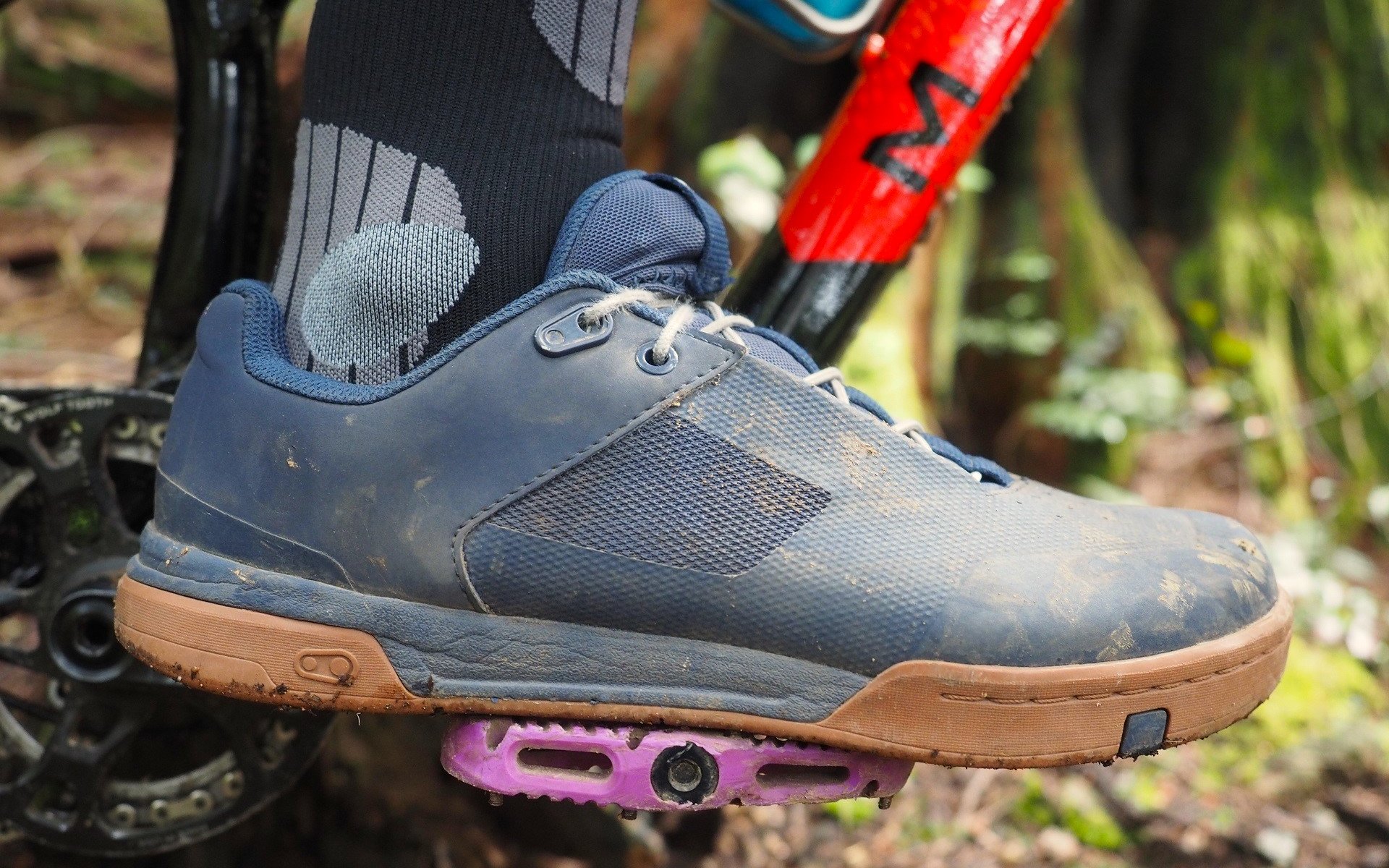
EDITORIAL
Flat Pedals, Foot Position & Reach
Relearned Behaviour
There is a factor that impacts reach that I haven't seen discussed before; specifically how two riders of the same physical proportions on the same bicycle can have very different fit experiences. But before I can get there I need to do a bit of house keeping.
In January this year I ruptured my right Achilles tendon. I wrote something about it at the time. I had excellent care in the emergency room at Lions Gate hospital, excellent advice from friends and my physio, did my exercises, and I'm working on getting my strength and fitness back up into riding shape - mentally and physically. To say the least, I'm grateful. But as I return to the trails I've been struggling to reset the fit of my bikes and to then relearn how to ride them. It's now constantly in the back of my mind when I'm riding.
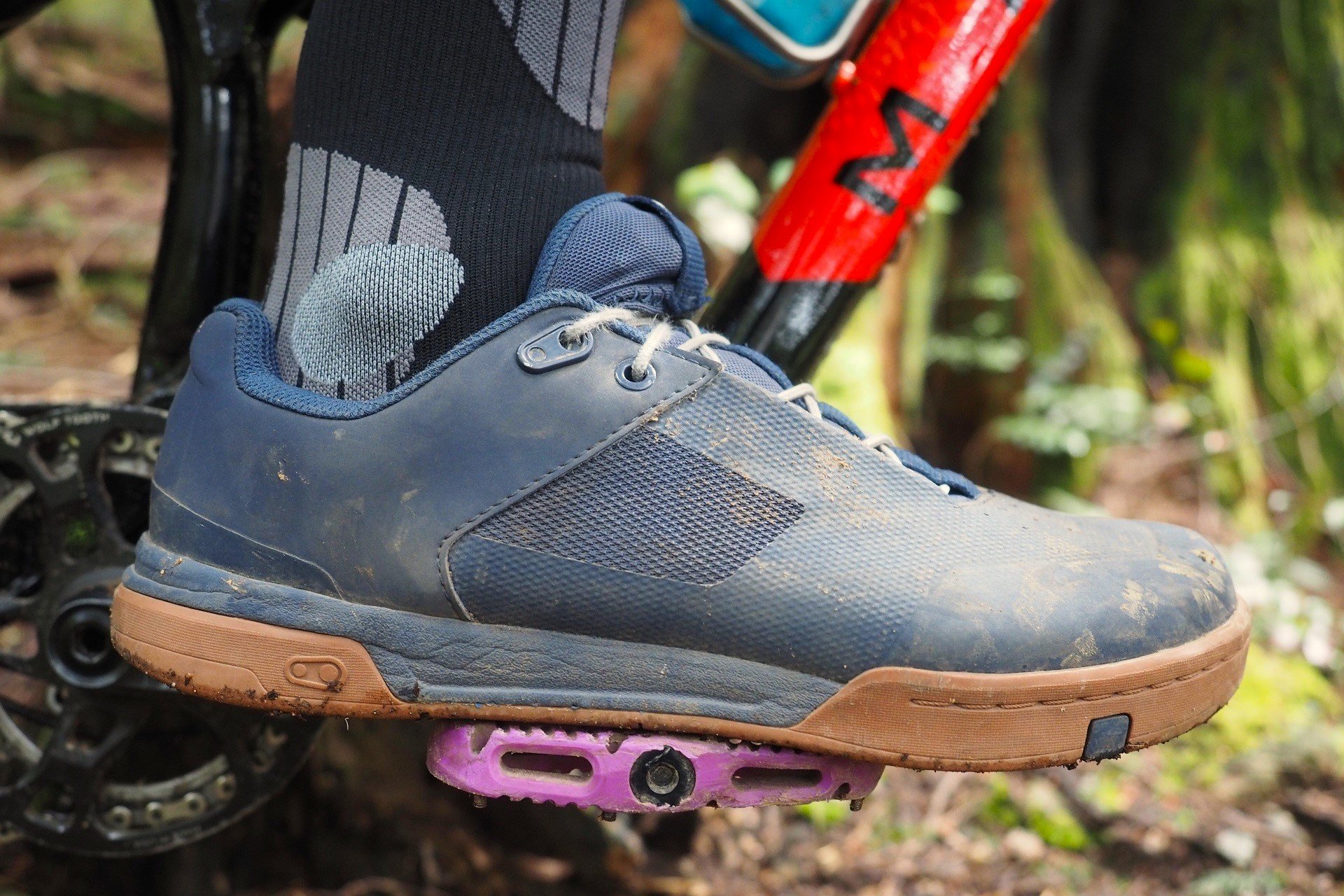
Where my foot sits now, regardless of the pedal I use. Photo: The Clairebarian
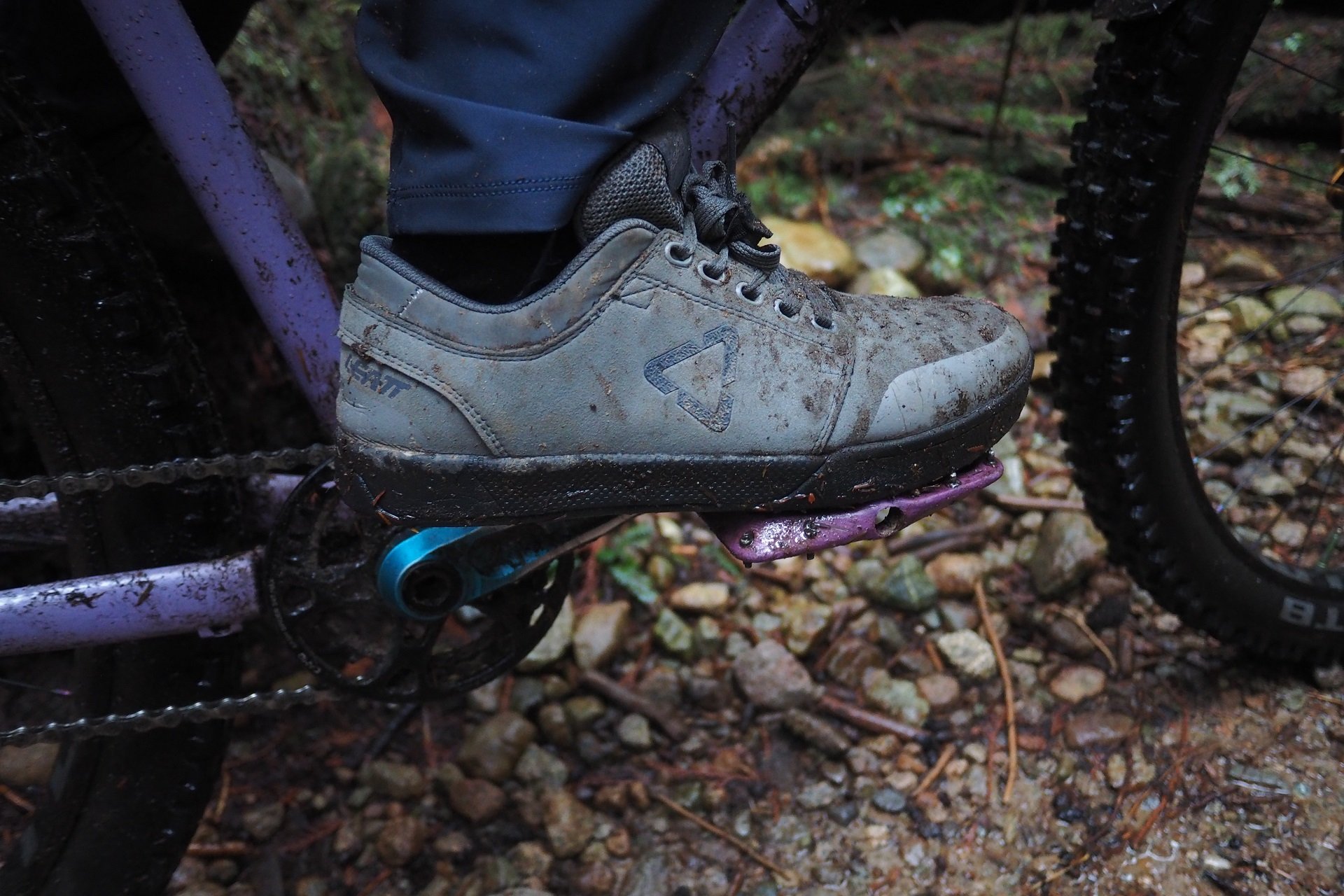
Where my foot sat before my injury. Photo: Mr. Lungtastic
If you had asked me before my injury about the position of my foot relative the axle of my pedals I would have told you that I ran my foot forward of most riders. I would have been wrong, but in my defence that understanding came from over two decades of riding clip-in pedals. My cleats had been migrating rearward in my shoes year-on-year until I started seeking shoes with the most rearward position, like my all-time favourite the Bontrager Rally, or modifying shoes with longer cleat channels to mimic the Rally's positioning. As it turns out, relative to many of my friends who've been riding flat pedals on mountain bikes for years, my foot position was still very much in the range of the ball of my foot being over the axle of my pedal.
As I returned to pedaling after a wearing out a walking boot getting my kilometers on foot, I managed the epically boring stationary trainer, miles to nowhere, by setting up my bike outside and singing along to music. I was on my beloved V2, unchanged but for the slick rear tire and significantly smaller cog, but I did a lot of my riding sitting bolt upright and even when I was getting my sweat on in a more aggressive position I didn't notice how much my pedaling and positioning had changed until I was back on the trail.
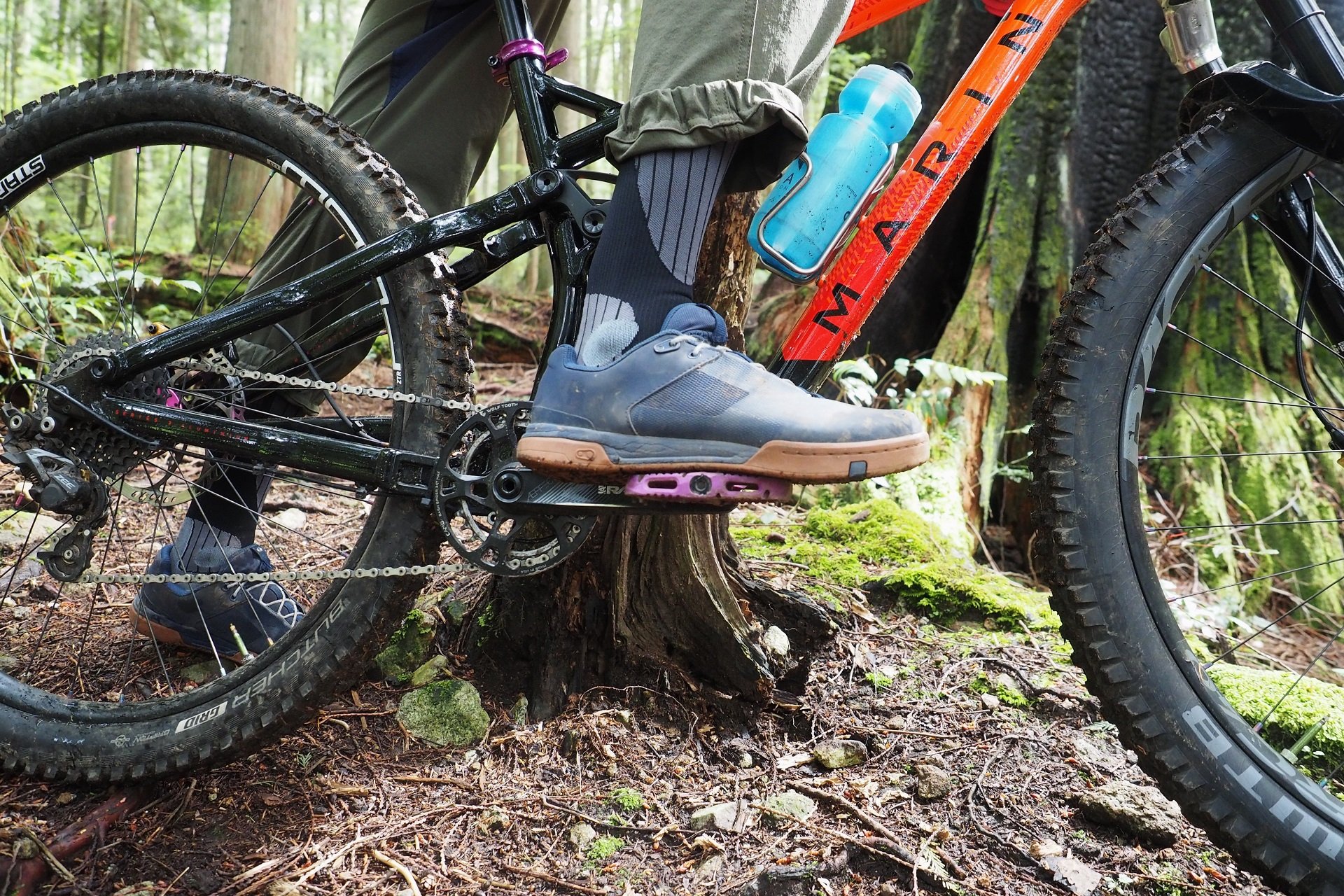
Bike fit really starts from where your feet sit on the pedals which means my riding position has shifted forward on my bike. Photo: The Clairebarian
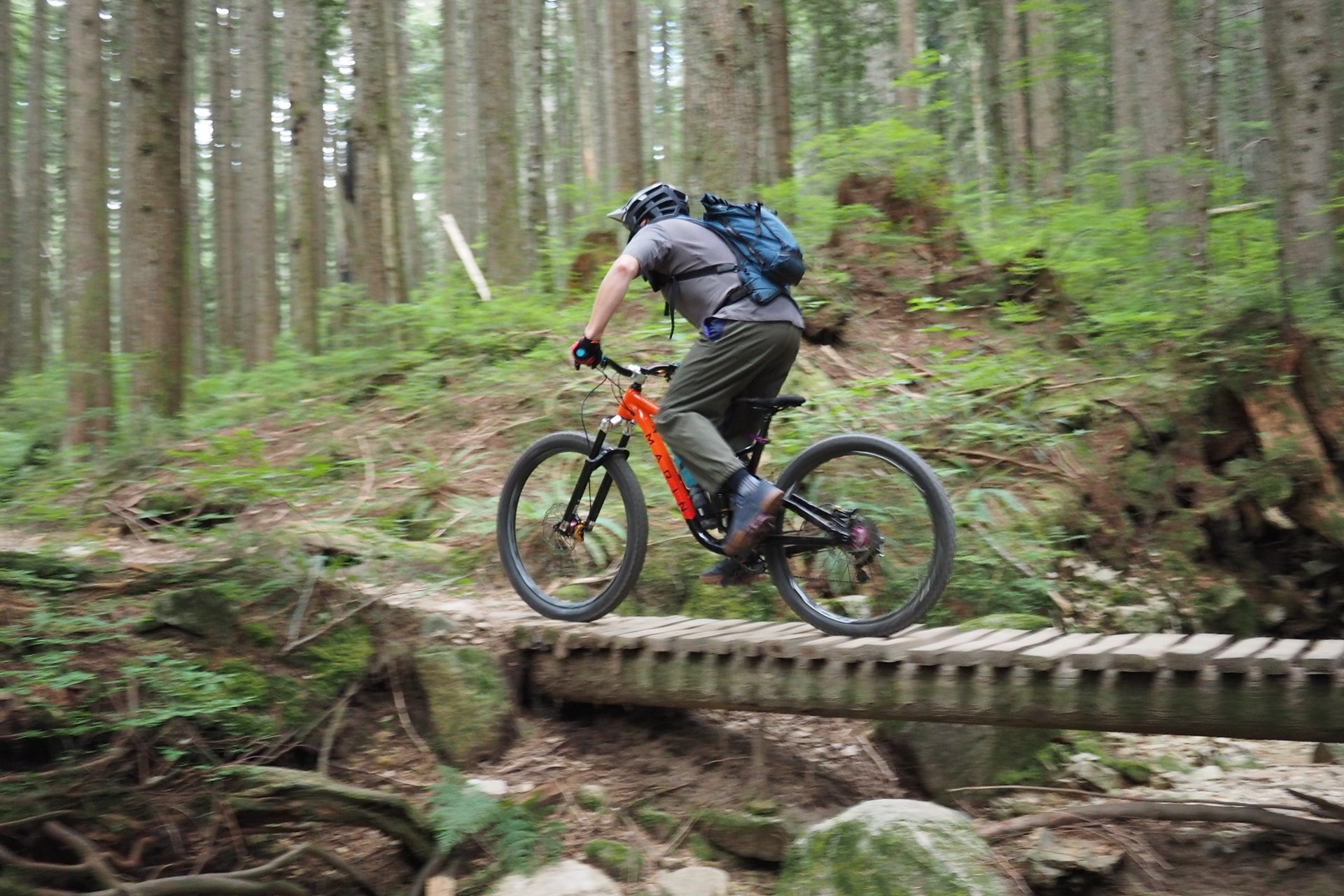
I've been playing with positions that increase my stem length and move my saddle forward in the rails relative to pre-injury. Photo: Mr. Lungtastic
OneUp Vs. OneUp
I want to quickly address a micro-controversy entirely of my own stupid making when it comes to a preference for OneUp Composite or Aluminum flat pedals. Both share a similar convex shape but the aluminum pedals use a much thinner body with a flared inner section housing a larger cartridge bearing, and the plastic (composite, resin, glass fiber, etc.) version using a more standard layout internally with a thicker body and sharper threaded machine screws rather than the smooth pins of the alloy option.
In my experience, having used both types, the composite pedals have better grip and a more consistent platform. I ride with many who prefer a concave or flat pedal shape, but of those who ride OneUp pedals and have tried both, the plastic option is the preference. So, I assumed that was universally the case. In fact, many riders prefer the aluminum option in a blind test, which has nothing to do with the pedal material. After asking a group of people about their preference of one or the other ,I can only say that footwear and foot size don't seem to be relevant. Some prefer the aluminum version and say it offers more grip and some say exactly the same thing about the composite.
For a while it had me rethinking writing this piece. How can I say anything about pedal shape when there's such a difference in experience between pins and materials? I decided it was worth penning regardless but I want to double down on noting that the following material about pedal shape is entirely my experience, though I think the conclusions about bike fit are more universally interesting. In any event, a preference for one OneUp pedal or the other really does circle back to how important it is to try different things for yourself and particularly with contact points; grips, pedals, and saddle.
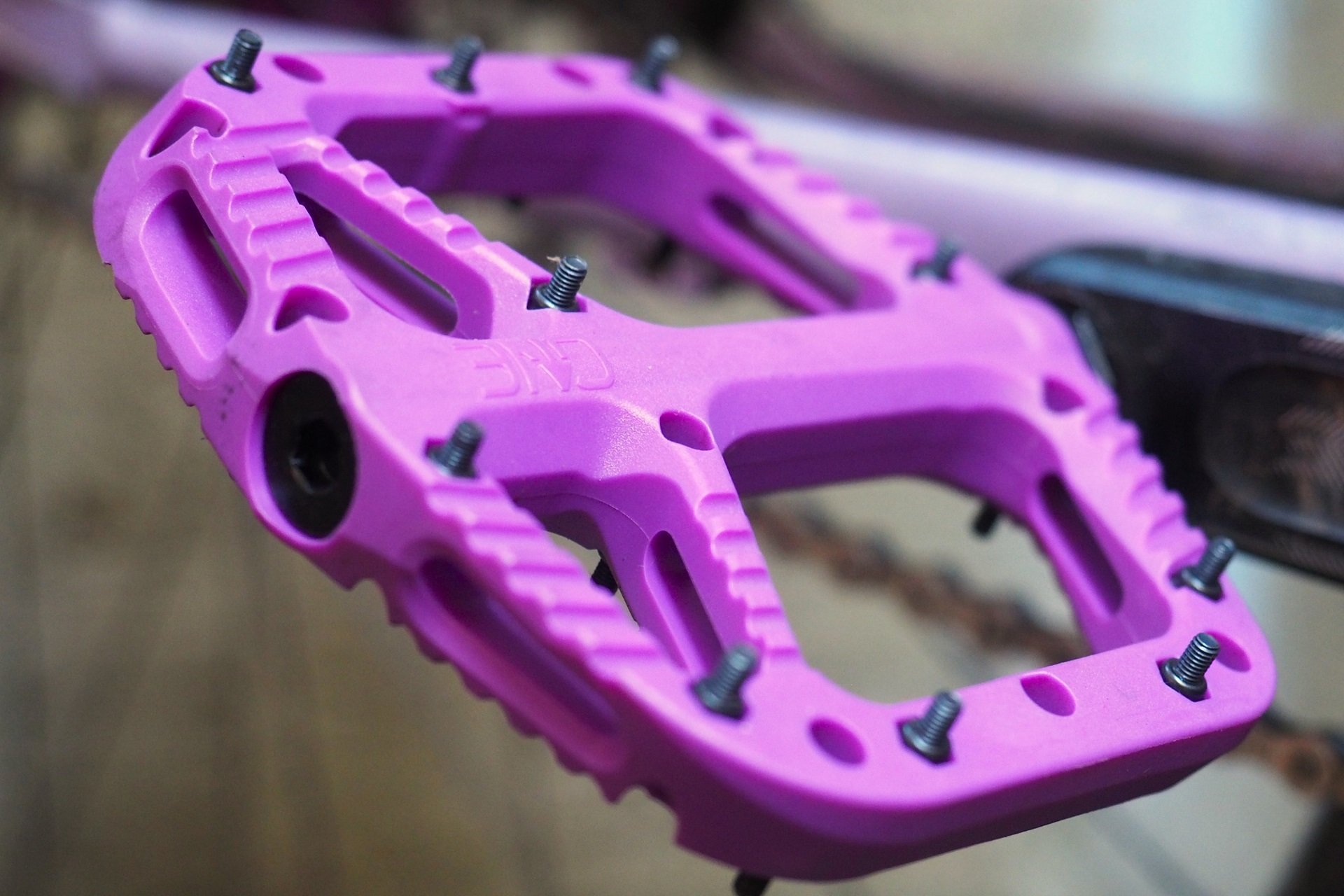
OneUp makes both an aluminum and a composite (plastic) model. They both have similar concavity but very different pins. The aluminum model is also thinner for those who prioritize that.
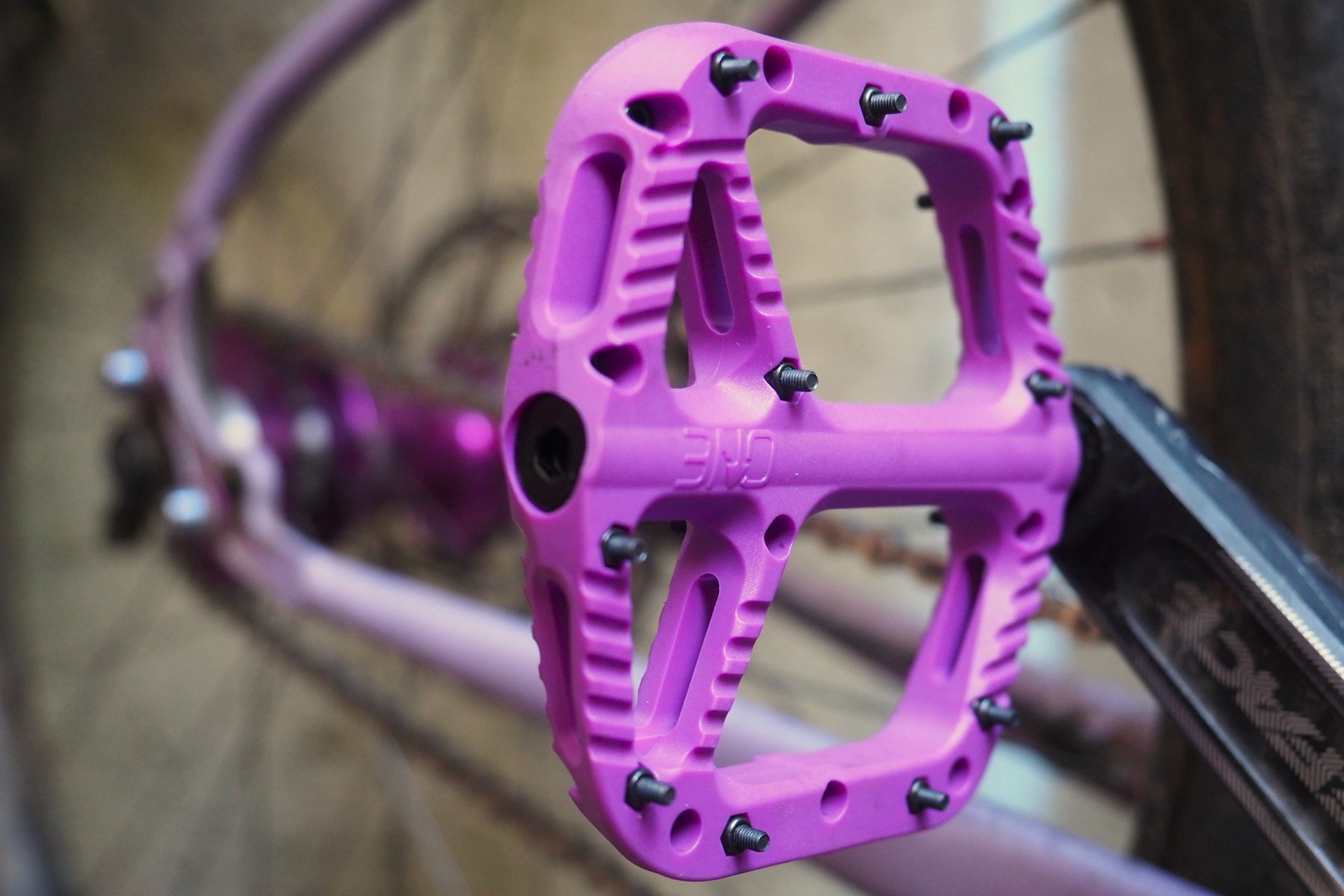
Most who've ridden both, regardless of the tackiness of their shoes, have a strong preference for one or the other. I thought the composite was the heavy favourite but there are certainly many who feel the opposite.
Concave, Flat, Convex
I've long been in the camp of Chromag, North Shore Billet, and other companies pushing a true-concave pedal shape. That is a concave shape to the pedal body, not one that is created by varying pin-height. I found that with pedals of this shape I was much less reliant on sticky-rubber shoes and wickedly sharp pins for grip. My feet would more naturally landmark a consistent position - something that has been more of a challenge for me with truly flat pedals. Once larger platforms became more popular and I fully converted to riding flats, the support was superior to other shapes. Easily my favourite pair of pedals to ride are my timelessly-raw aluminum North Shore Billet Daemons.
On my first trail ride back I was finding it impossible to get the traction I expected from my Daemons, with the same pair of Crankbrothers Stamp shoes I was riding before my injury. My foot wasn't landmarking properly and when I tried to force it into that familiar high-grip position everything seemed wrong. So, I closed my eyes and let my foot rest where it may, and that position is at least a couple centimeters forward of my old happy place on the pedal.
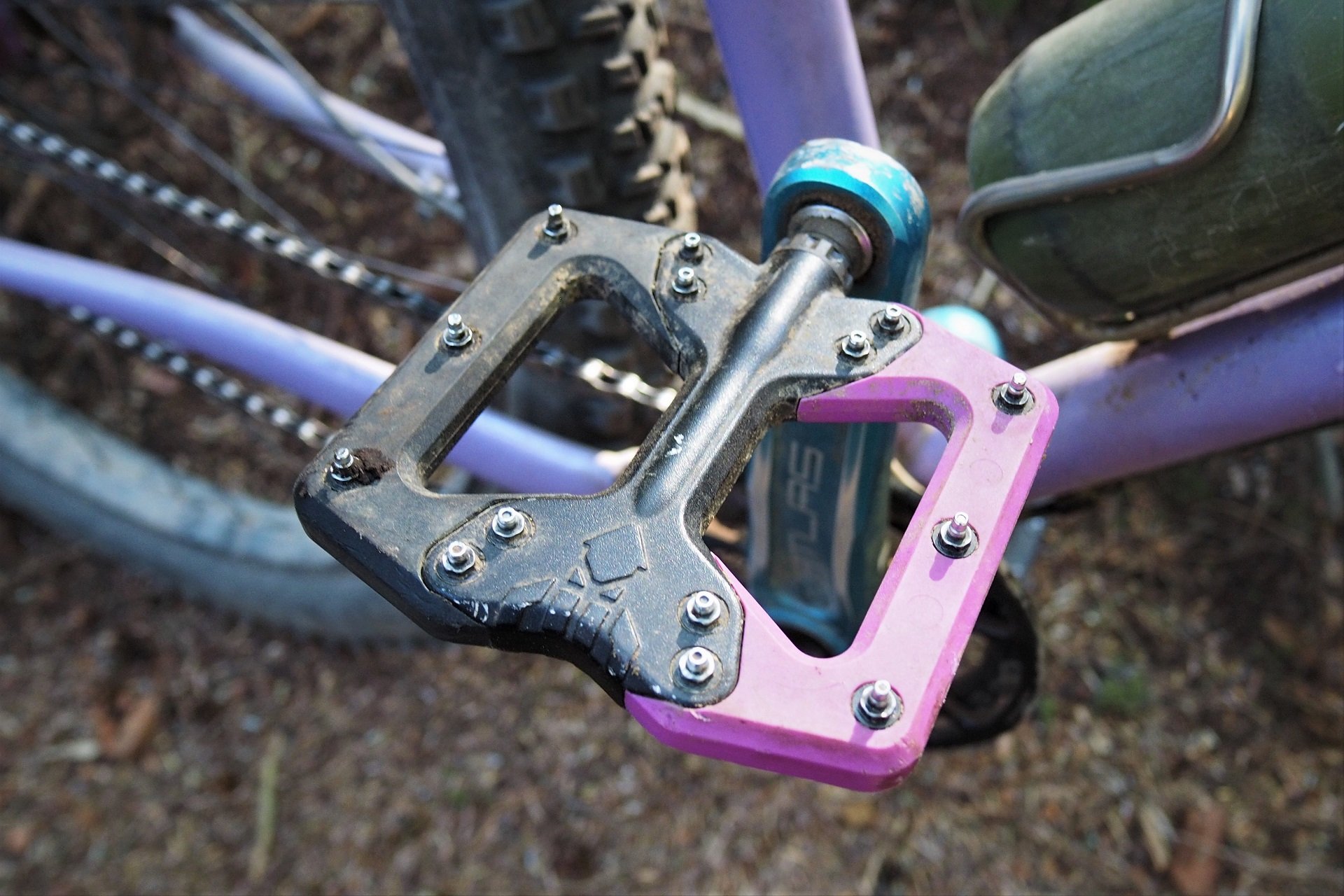
If in doubt, grab a flat-flat pedal. Squidworx is a great choice thanks to an awesome axle system and the unique modularity. Since my review I have many hours on these pedals commuting and trail riding and they spin like new.
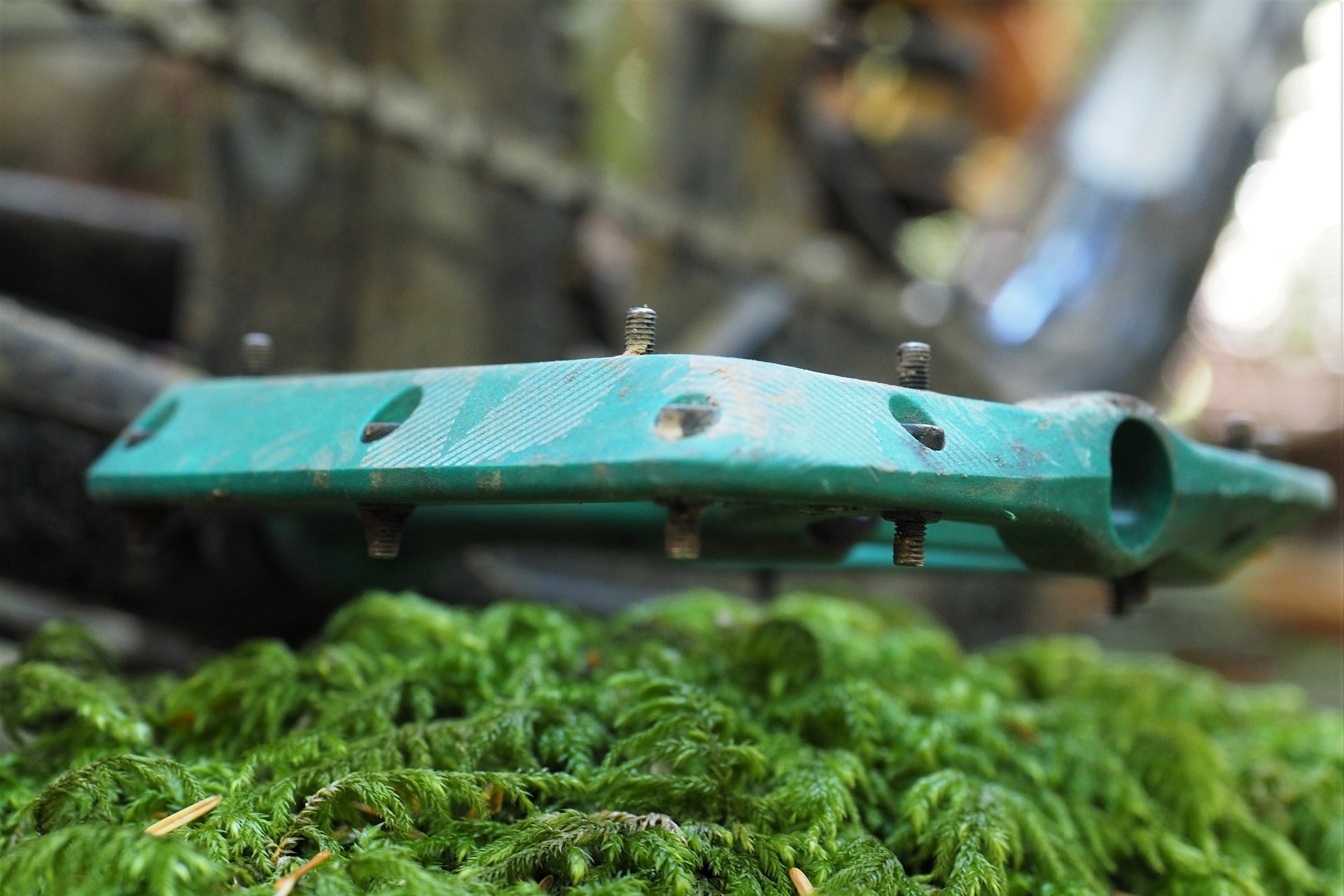
My favourite flat-flat pedal on a budget is Kona's Wah Wah 2. It comes in two sizes though I've only ridden the larger 120x118mm platform. I wish they also made an XS size as the small 110mmx108mm platform isn't quite kiddo-sized.
For my second ride back I went with a pair of truly flat pedals, the Kona Wah Wah 2. This is a pedal I've always been able to adapt to, but just how much of an improvement they were had me revisiting my review in 2018 where I concluded that "if the Wah Wah 2 had a more accentuated concave shape they would be my personal go-to." The same is true with the modular Squidworx pedals, which jumped appreciably in my ranking of pedal choices given their excellent axle system.
Next on my list is a pair of OneUp Composite pedals, which have previously been usable but far from my favourite with any shoe other than Leatt's 2.0 Flat pedals. They work very well with the waffle pattern on Leatts regardless of foot position. Mechanical grip was always fine thanks to the sharp pins but I always felt like I was fighting the shape. Where my concave pedals guided me home to my happy place, and truly-flat pedals were a bit vague but rideable, the convex OneUp pedals always felt like my foot was in the wrong position. Which, well, it was. I had a properly beaten set I bought at the shop I was working at to see what the fuss was about, but they were never more than an on-again off-again choice whenever I was on new shoes. Most of the reason they looked so battered was that they ended up on my very low Yeti SB104 BBR (Before Brunch Ride).
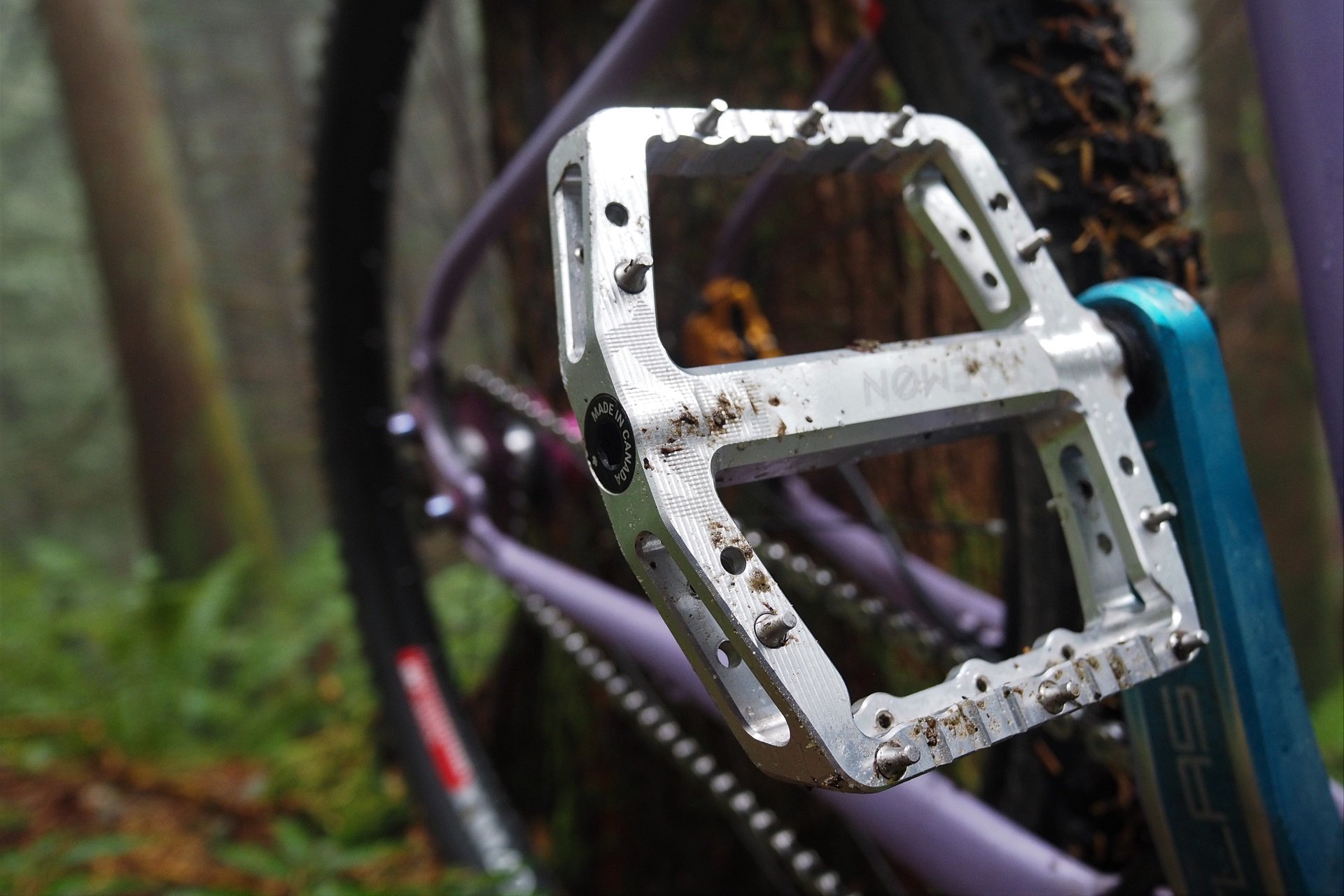
Canadian-made concavity. A silver pair of North Shore Billet Daemon pedals should last you forever assuming you don't completely change how you pedal.
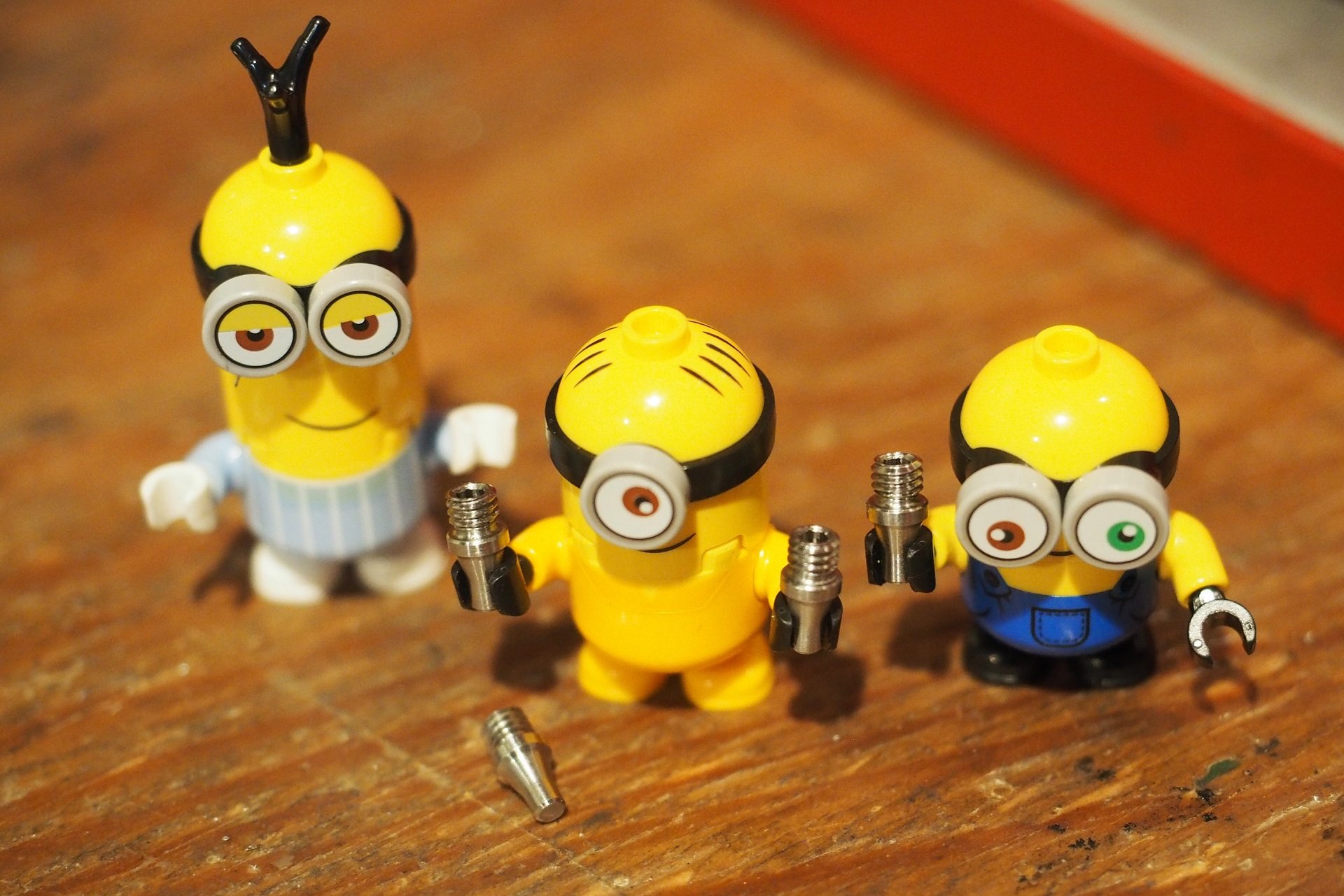
The minions at NSB make the bodies, axles, and even the pedal pins in-house. I already pitched OneUp on limited edition NSB-made convex pedals, but I don't think it's happening.
Where truly flat pedals, like the Squidworx and Wah Wah 2, have jumped up in my personal estimation, the difference in riding OneUp's pedals was an absolute night-and-day experience on the trail. Traction, support, and landmarking all remind me of using the Daemons before my injury. This led to a great deal of photo taking, cloud drawing, phoning friends and general ruminating over a whiskey or two with, I think, a fairly appliable conclusion.
My friends who prefer a concave pedal, many of whom rode BMX bikes as kids, tend to have the ball of their foot more over the axle. My friends who prefer convex pedals tend to have the arch of their foot more over the axle. My friends who prefer truly flat pedals fall into both camps - these are the 'Type O' of flat pedals clearly. But ignoring the truly-flat pedals those who much prefer a concave or a convex shape universally use the corresponding foot position I've noted. I'm not bolt enough to claim that's true of everyone but if you do have a strong preference on pedal shape I'd be curious where your foot falls.
I've yet to meet someone who rides with the ball of their foot more over the axle who likes OneUp pedals. I've yet to meet someone who rides with the arch of their foot more over the pedal axle who prefers a concave body.
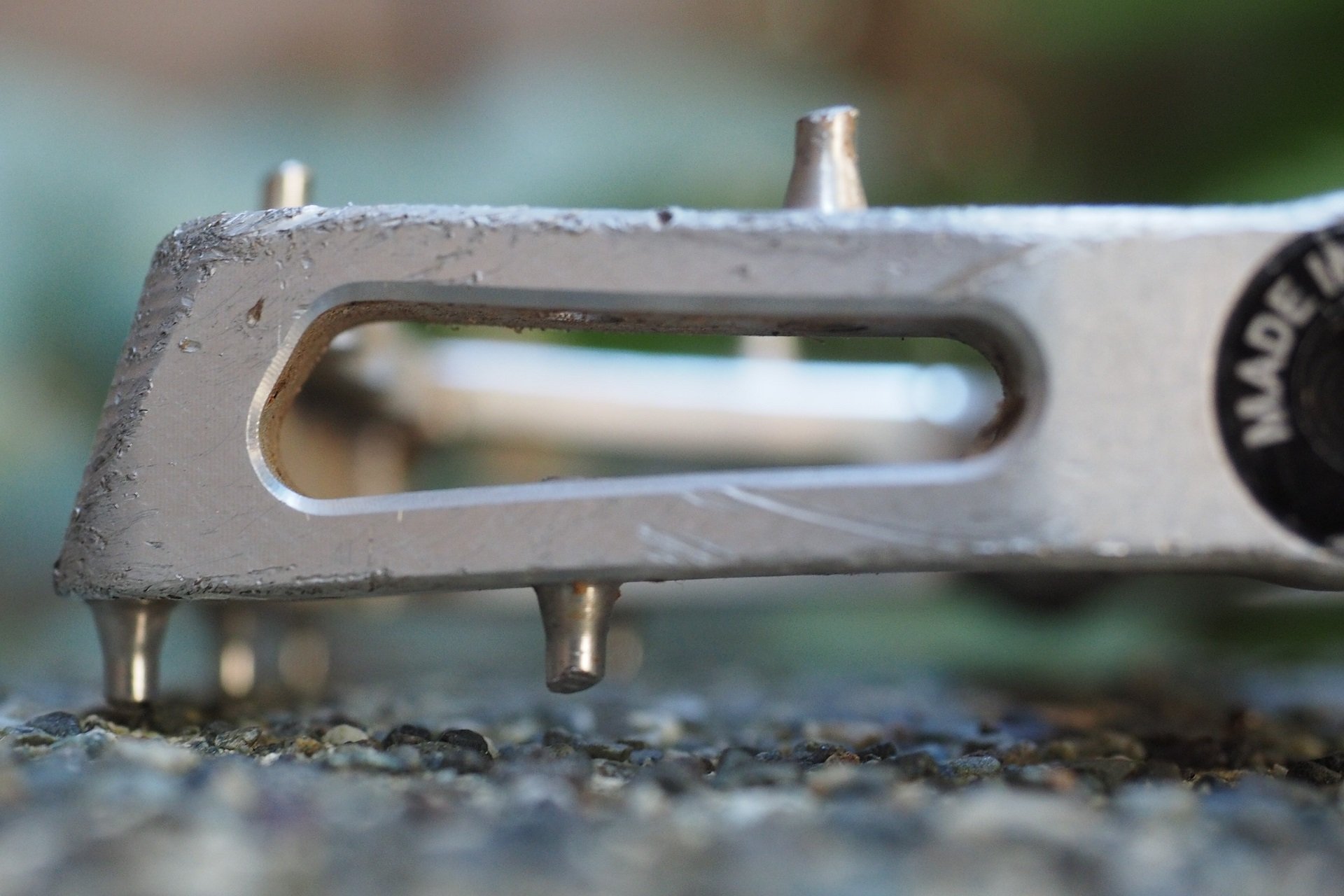
My concrete bunker is far from a certified-flat surface, but I think it's pretty easy to see the concave pedal shape in this photo.
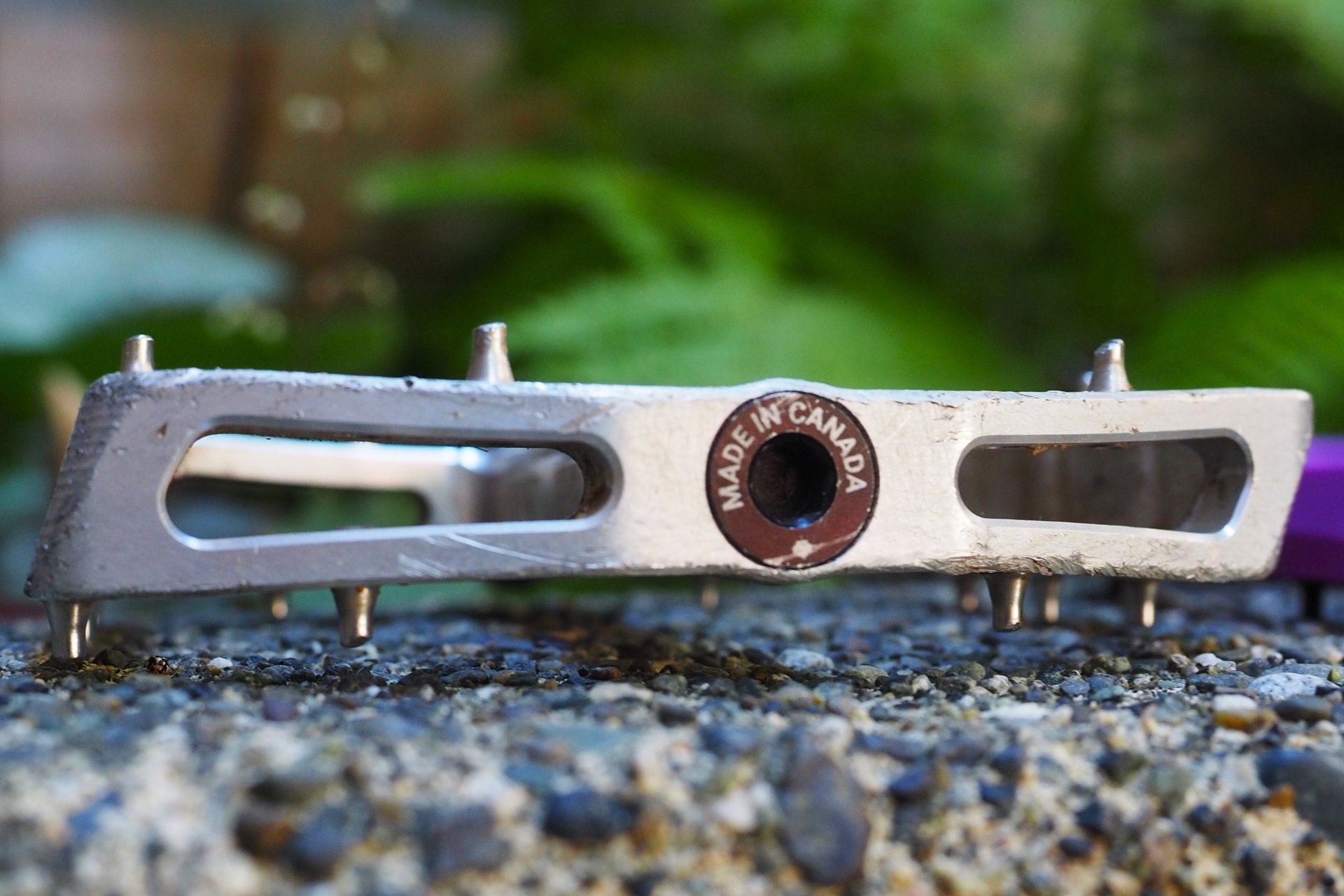
My personal experience is that this shape works best with a foot position where the ball of the foot is more over the axle of the pedal.
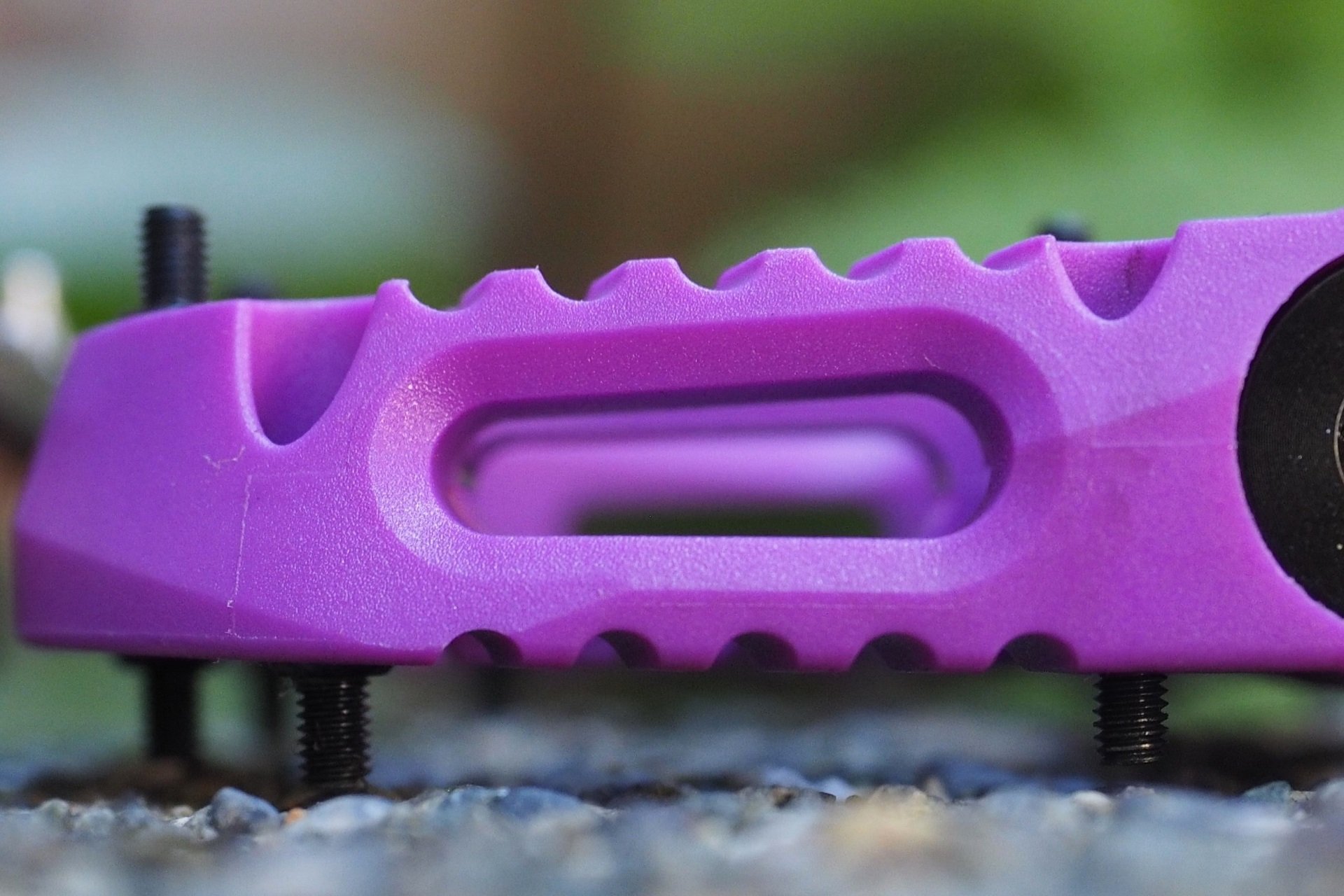
For comparison, here's the convex shape of the OneUp Composite plastic pedals. It's not as pronounced as NSB's concavity but it is notably not flat-flat under foot.
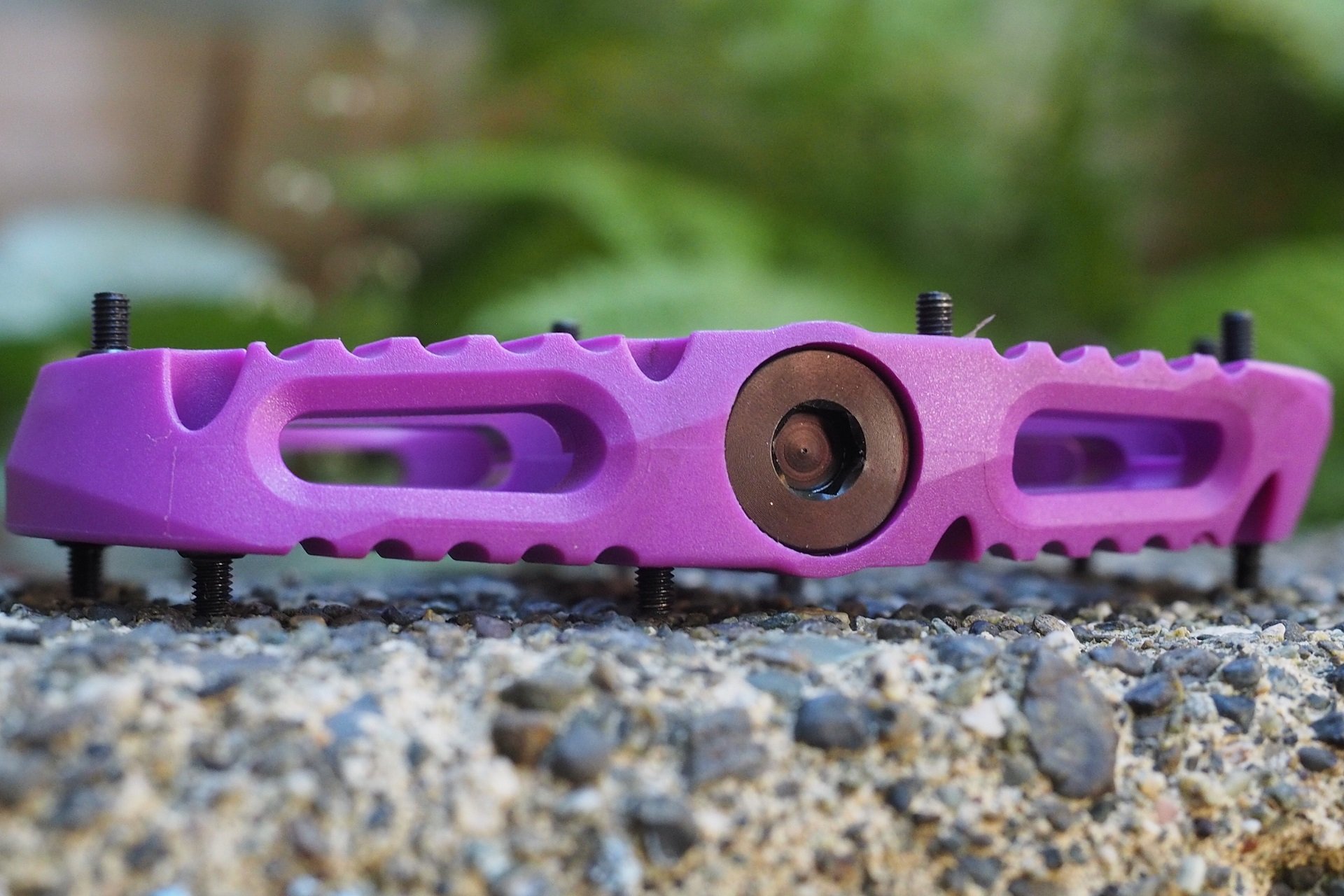
My personal experience is that this shape works best with a foot position where the arch of the foot is more over the axle of the pedal.
Frame Geometry
Try a few flat pedal shapes, buy the one that works for you, and go for a ride, right? Why does it matter if this Andrew prefers a convex pedal and rides more arch-over-axle and the old Andrew prefers a concave pedal and rides more ball-over-axle? Is this all just setting up a future article where as his leg strength improves he goes back to the position he was used to for over two decades? Is it a rule that articles with any third-person narrative can only go live on Wednesdays?
It seems that with pedals, I have more questions than answers, but not so with bike geometry. I was a few meters into my first proper descent in months and was thinking I must have a grown a couple of inches. Or maybe I no longer have T-Rex's ape index? Something had happened because the Reach on my custom rig felt significantly shorter than I remembered. It's true on my commuter bike too. And suddenly my brother's Guerrilla Gravity feels like it's my size. Bikes where I was previously on the fence between medium and a stretch to large now feel decisively better in the larger size.
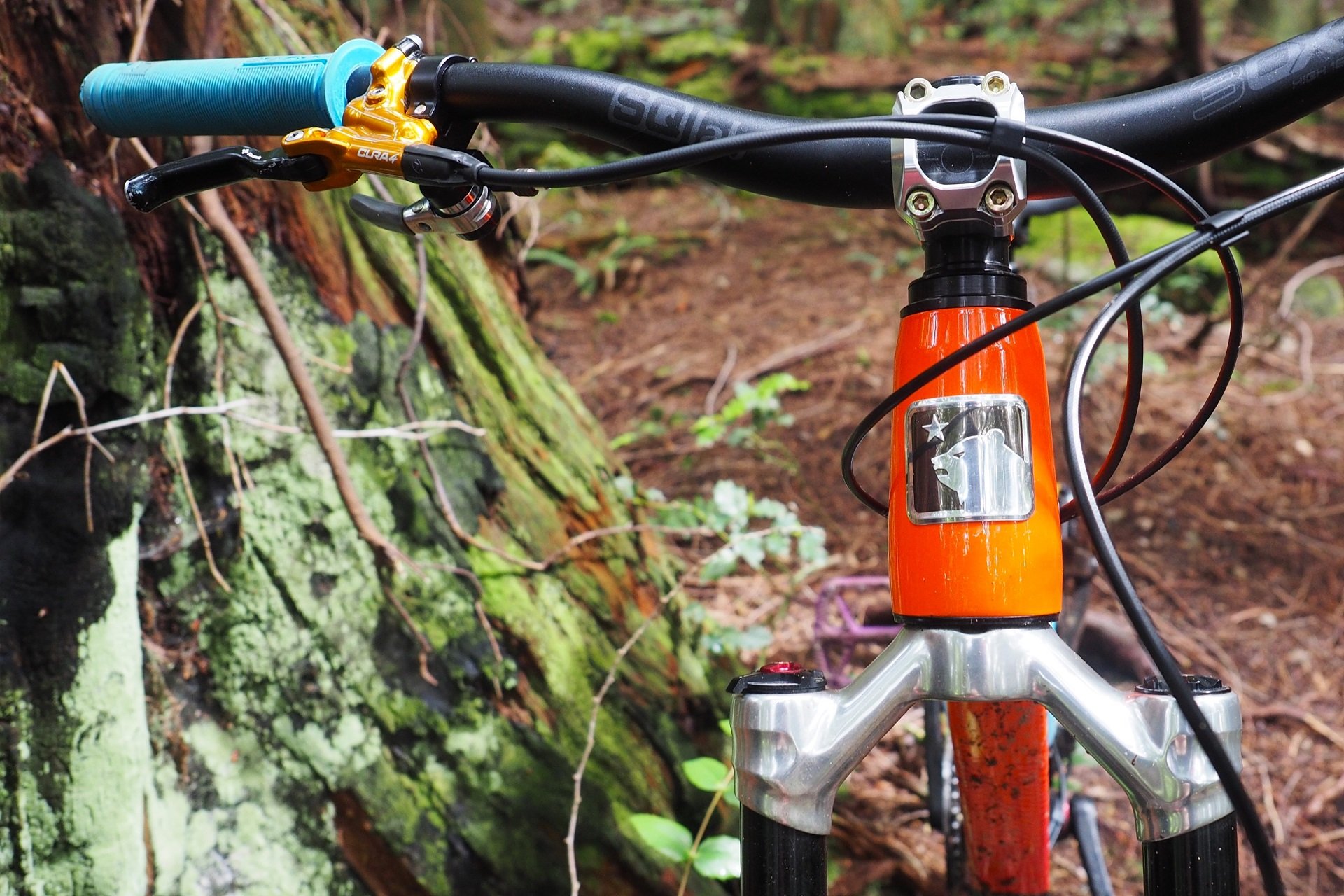
With my new more-forward stance I've played with lowering my bar and lengthening my stem on my full suspension bike.
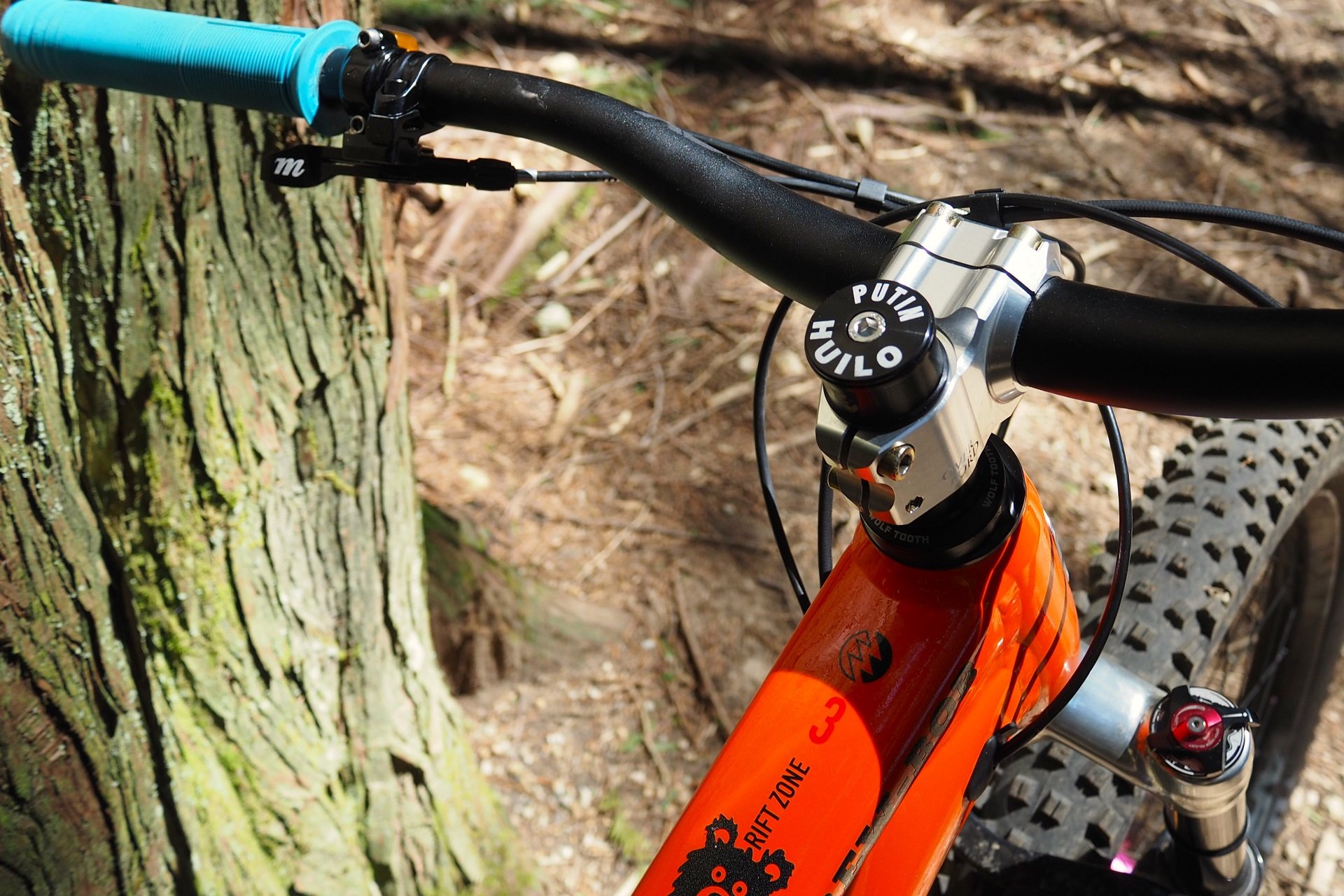
I'm currently running a positing that moves my saddle and my handlebar 1cm forward and also lowers my bar 1cm from where I expected them to sit pre-injury.
It's bike geometry, not rocket philosophy, and there's of course a simple explanation that you can experience with at home. Get on your bike with your feet in your natural position on the pedals, leaning lightly against a wall on flat ground like you were going to check your suspension sag and attune yourself. Now lift one foot and then the other and move them each forward 2cm or so. Sit down. Does your saddle feal like it's moved rearwards? Like someone slackened your seat tube angle. When you stand up, does your bar feel a lot closer to you?
I'm 5'9" tall and my Waltworks has a 480mm Reach, 601mm Stack, and a 665mm effective top tube thanks to a 73.5° actual seat tube angle. Yes, I run a 16° backswept bar which does shorten the overall feel of the bike, but in general it's towards the longer range of a frame for someone my height. With my new stance on the pedals it feels like it's a couple of centimeters shorter and that's because, functionally, it's just that. So much so that I've been playing around with stem length.
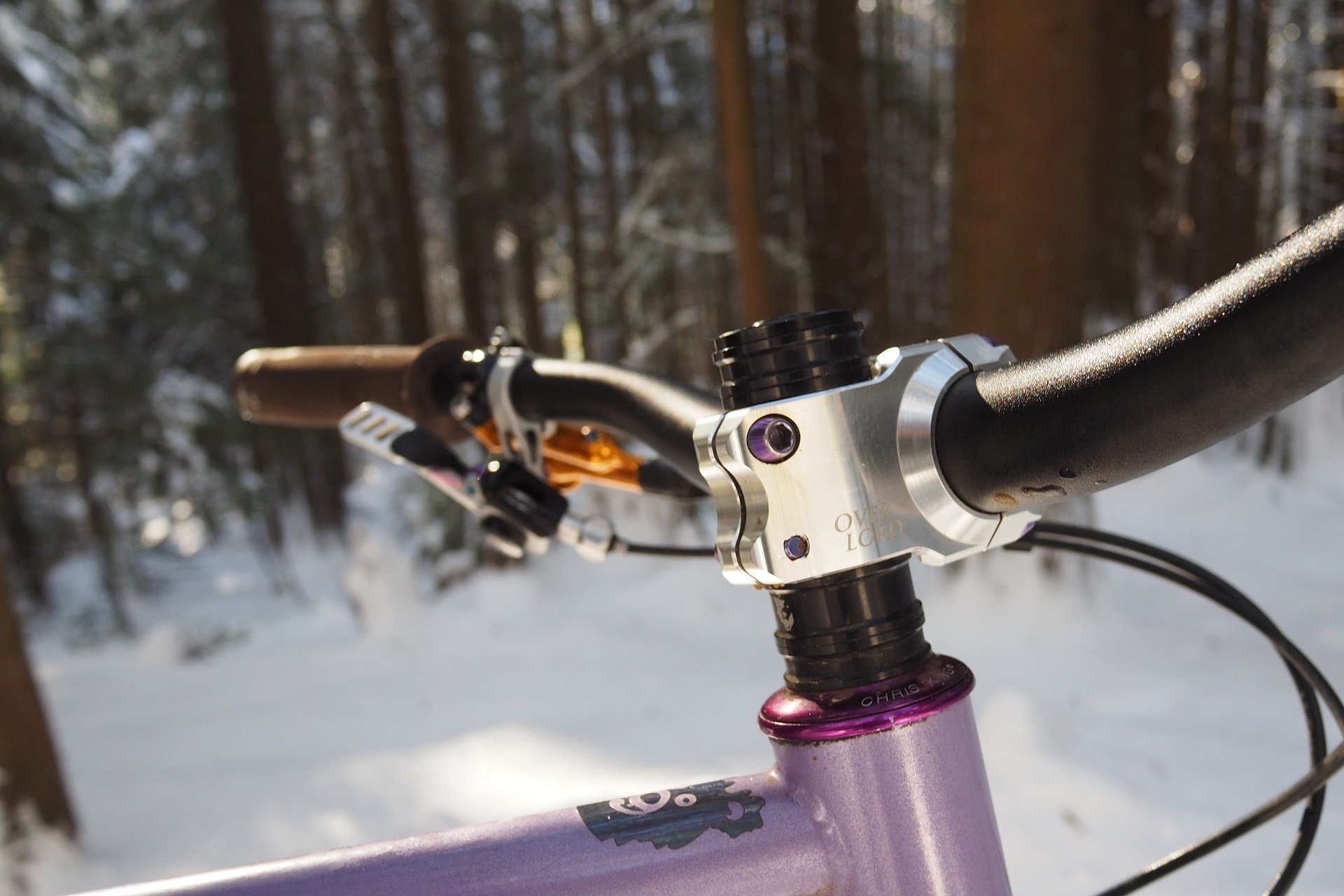
On my hardtail I haven't yet changed the stem length or height from were I've had it since December '21. I'm enjoying the balance of the rig with the chainstays set long and the slightly shorter front end feel.
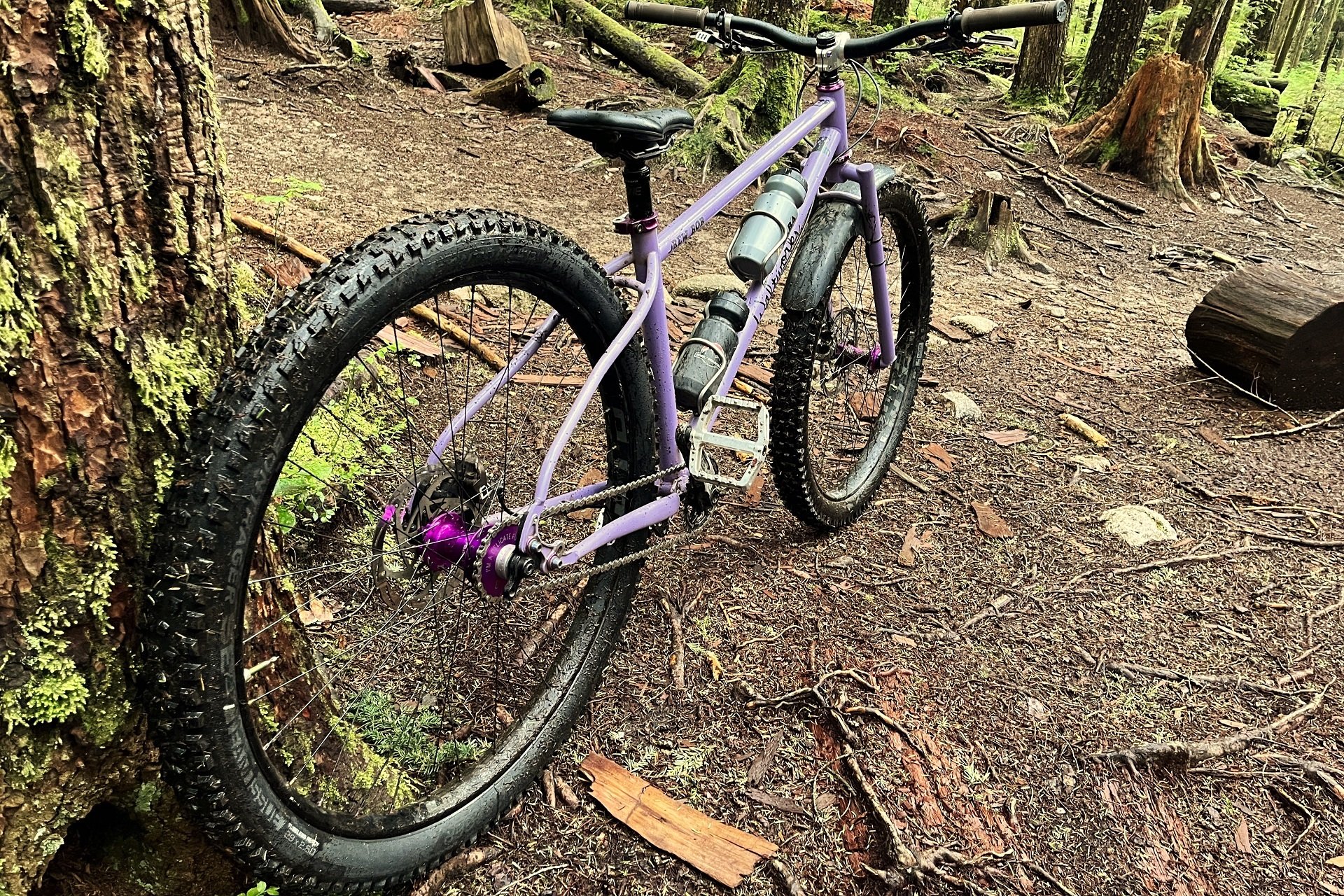
So far all I've changed on the #1FG bike is to move the saddle forward about 1cm and to swap out my beloved Daemon pedals for some OneUp Composites. I am going to try a different saddle as well and then maybe a longer stem too.
Just as returning to riding with my new foot position has made me think about why a rider would prefer one platform pedal shape over another, I also feel I now understand one reason there's such a variation in preference around Reach and yet, two riders with the same approximate body dimensions will make the same claims about very different numbers. Our first Andrew with the ball of his foot more-over his pedal axle preferred a slacker seat tube angle and found a 480mm Reach perfectly long. The second Andrew with the arch of his foot more-over his pedal axle has shifted his saddle rails forward in the clamps about a centimeter and lengthened his stem by the same will next be trying an extra centimeter on each again.
I'm not looking to build a matrix or make any general statements about mountain bike fit, and as always personal preference wins the day. But it's with a new eye to folks' feet that I now listen to people talk about whether they like to upsize or downsize their bicycle relative to a manufacturer's sizing chart, talk about seat tube angles, reach preferences, and, flat pedal shape. I don't know if my new foot-on-pedal position is permanent or just part of a journey back to full capacity, which will likely take another six months, but it's been an interesting and revealing experience.
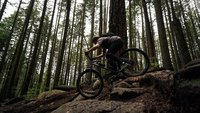
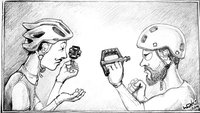
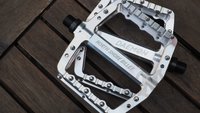
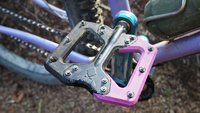







Comments
Kenny
1 year, 7 months ago
The concave = ball of foot placement convex = arch placement always made sense to me intuitively, but somehow the impact on "effective" reach never occurred to me!
In my large cache of pedals I have a set of DMR vaults (very concave), I've always felt I ride better with those pedals than one ups (which I have been running most of the time lately), but the make my feet cramp up (additional leverage on my feet from the ball of foot position).
Somehow I missed that maybe bike fit and general position on the bike works better for me with my feet more rearward.
Makes me think I should try again, maybe fitness wise my feet will get used to it if I commit for a few months and work up to longer descents with them.
Oof. Another variable to throw in my overanalyses shitstorm. Lol.
Nice article Andrew!
Reply
Andrew Major
1 year, 7 months ago
Thank you, Kenny! I'm stoked to hear what conclusions you come to so post up. I do think OneUp could offer a larger (longer) platform as well as a smaller (kids) platform and both would be well received.
"Oof. Another variable to throw in my overanalyses shitstorm. Lol."
The thing is, in my case at least, I'm talking about a couple of centimeters. Most current aggressive bike geometries don't even allow for that much adjustment in stem length (35-50mm) = 1.5cm). Relative to discussions about Reach, Stack, etc. it's a large difference.
I don't know if I'd claim there are advantages to it, as in I wouldn't go back in time and try to teach myself to ride with a more arch-over-axle position but this whole process has been an interesting journey. I'm still doing quite a bit of stuff to strengthen my calf and foot muscles so it will be interesting to see if I migrate back to my previous position over time.
Reply
bushtrucker
1 year, 7 months ago
The only advantage I could see with an arch-over-spindle position on flat pedals is when attempting to land a decent sized drop/jump. With a forward position on the pedal landing seems less likely to place a rotational force on the foot making it easier to hold the position on the pedal.
Reply
Andrew Major
1 year, 7 months ago
There's certainly less force on the calf muscle landing off of stuff (though I'm keeping it very, very low to the ground) and also punching through janky terrain. Maybe at a trade-off of pedaling power on the climbs since there's less flexion pushing through the pedal stroke?
Some of it is going to be pedal/show-centric, but I certainly never had a problem keeping my feet on my pedals with my previous positioning.
Reply
Karl Fitzpatrick
1 year, 7 months ago
I think what Bush Trucker is referring to is that a more forward foot position prevents your calves having to work too hard to stop your heel from sinking too deep after big impacts. I have quite flexible achilles/calves and my (very) forward foot/heel down position has saved me from pulling my foot off my leg haha...
My midfoot position is actually slightly forward of axle so yeah...
Reply
bushtrucker
1 year, 5 months ago
Ah missed this reply. Yeah exactly this.
khai
1 year, 7 months ago
Ball of foot over the spindle is absolutely more efficient for pedaling (see any XC racer or roadie for that matter) but it puts more strain on the arch/calf/Achilles than does a more midfoot position. Midfoot over the spindle is a biomechanically stronger position, but that strength comes at the expense of range of motion and optimal pedaling efficiency.
After riding with loose cages way back in the day and then upgrading to clipless for a long time, I transitioned to flats somewhat slowly - preferring to be clipped in for fast/rugged terrain and to be on flats when riding skinnies and other lines where the need to quickly jump off and not have the risk of a foot getting hung up, or just hang a leg for balance was paramount. This is related to foot on pedal position because most clipless shoes have a very small range of adjustability, so one is forced into that efficient/ball over spindle position.
I started to (deliberately) use a more centered foot position when I experienced foot/calf fatigue in the bike park and during longer downhill runs without stopping. With a closer to midfoot position I can ride [downhill] longer, and with less fatigue than when my foot is further back on the pedal.
Nowadays I move my feet around a fair bit - ball over the spindle when seated for climbing and mellower undulating terrain, and more forward when it gets steep/long descents/rough terrain/jumping/drops. More simply, I tend to climb with the ball over the spindle and descend with the midfoot a bit closer to over the spindle. One does lose a bit of ankle articulation when moving the foot forward on the pedal but I feel that the tradeoff is worth it.
As far as pedals go, I ride Daggas most of the time and Crank Bros Stamp 7s some of the time. Both are fairly large platform and I don't have big feet at all, but I like the support.
I'm a bit surprised that the change in bike fit relative to fore/aft foot position never occurred to me. Perhaps it's because when I'm standing I've typically got a closer to centered/midfoot position and when seated I have a more ball over spindle position - though for tech climbs when standing I'm not certain now... I'm going to have to focus on my feet for a bit over my next few rides. Thanks for this, Andrew!
Reply
Andy Eunson
1 year, 7 months ago
I think you’ll find very few pro road or xc riders do that ball of the foot, first metatarsal over the spindle any more. Most common now is to have the third metatarsal over the spindle. Some are experimenting with arch cleats too but I don’t think it’s popular. I think triathletes like further back cleats as it’s easier to transition to the run.
Reply
bushtrucker
1 year, 5 months ago
Yeah a foot forward for more efficient standing pedaling and more control descending is something I'm experimenting with too. Love the train of thought this article started. Always something to learn!
Reply
Andrew Major
1 year, 5 months ago
I've really enjoyed how much thought folks have put into their flat-pedaling, it's been quite inspiring. I've been playing around with moving my feet for climbing vs. descending which works better with some pedals than others.
Kenny
1 year, 7 months ago
> The thing is, in my case at least, I'm talking about a couple of centimeters. Most current aggressive bike geometries don't even allow for that much adjustment in stem length (35-50mm) = 1.5cm). Relative to discussions about Reach, Stack, etc. it's a large difference.
Exactly that's why I'm a little gobsmacked I'd never considered it, it's almost an entire frame size difference! Interesting.
Reply
Andrew Major
1 year, 7 months ago
I had the same reaction. "Why does my bike feel notably smaller? Oh, ohhhhhh."
Reply
Duncan Wright
6 months, 2 weeks ago
Sorta necroing the comment thread here, but someone just pointed me to this article after I kind of had the opposite thing happen. At 6'1" on an XL Izzo, I got a bike fit and the fitter moved my cleats from under the fifth met head (basically right between your before/after pictures) to the classic ball-over-axle position - which made the bike feel unbalanced and uncomfortably long. Then, I bought an S5 Stumpjumper Evo (flats in the parking lot), put clipless pedals on it with the same shoes from the Izzo, and found it was again too long, until I put flats back on it. I grew up riding flats, so my inclination is the opposite of some - 5th met head over axle all the way.
Reply
Andrew Major
6 months, 2 weeks ago
These days many of my friends who clip in have moved their cleats rearward - some significantly - compared to in the past. I think it's a product of long reaches and steep seat tube angles.
Are you back on flats or staying clipped-in?
Duncan Wright
6 months, 2 weeks ago
I'm on flats on the Stumpy Evo and singlespeed hardtail, clips on the groad bike and the Izzo. For aggressive riding and hardtail stunting I like to be able to put a foot down/hit the eject button, and flats are easier on my knees.
Reply
DancingWithMyself
1 year, 7 months ago
Speaking of going back in time, you think people with a moto background or who currently mix a lot moto in with biking gravitate towards mid foot? Seems like that would be the case?
And this was another phenomenal article. Creativity always produces better and more useful articles than the latest widget. Please keep them coming!
Reply
Andrew
1 year, 7 months ago
Oh this gets me excited. I ride really midfoot and wear 11-12 us shoes. Right now I’m loving the pedaling innovations, but have spent the last few years enjoying the chromag daggas and the deity tmacs and deftraps. I haven’t tried a convex pedal in forever, and won’t unless it’s at least a little longer fore-aft. I love trying new things, and haven’t tried a pedal that’s ‘perfect.’ The deity deftrap would be if it were ever so slightly longer. Chamfers limit the length on the PI catalyst for how long it appears. I shattered my tibia plateau 3 weeks ago and have a rapidly diminishing calf and quad. Im really curious how that will affect me 4 months from now when I am supposed to be better. Good article and considerations. You shift your COM forward, and I like that on longer and slacker bikes. Keep it up and I’m curious if you’ll change as you heal. Or heel haha. If you want to borrow some near new catalyst pedals, I can get them to you.
Reply
Hugo Williamson
1 year, 7 months ago
32 years on post injury, calf is still smaller than opposite side.
I have found that I am more comfortable on a shorter reach bike 465- 470 as (5’10 178 cm ape index 0 ) as heels down on steep tech terrain inherently pushes one’s hips back, too long a reach produces a superman effect.
Burgtec composites are an excellent pedal I find.
Reply
Andrew Major
1 year, 7 months ago
Yeah, that's the general consensus on leg injuries - I'll never be a calf model. Some folks have said if I REALLY work at it but I'll be honest that I'm not as diligent with my exercises since I could ride again.
If you have a sec, one day when you're riding anyway, I'd be curious where your fit sits relative to your pedal axle. Not that I don't think there's a huge range of humans out there doing human things but academically I won't if my assumption that you're more ball-of-the-foot over your axle lines up.
Reply
Hugo Williamson
1 year, 7 months ago
Ball of foot rests just about on or behind pedal axle. 50/10 impact shoe, on Burgtec composite pedal.
Do occasionally move feet back slightly for jump lines, or steep tech slow speed tight trails.
Been riding flats for 15 years, coming from as you and Marty, years on clips.
Dan Critchlow owner of Burgtec has always ridden flats and at WC DH level, so has a reasonable idea of how a flat pedal should work!!
Reply
Andrew Major
1 year, 7 months ago
Ball on axle makes sense to me on all counts - sizing and pedal shape and tracks with what other folks are saying too - neat!
———
I would just say maybe that he has a reasonable idea how flat pedals work best for him, and that said shape also works for a lot of people. As many different shapes and styles that are out there, there has been a lot of thought and testing put into different designs - concave, plane, or convex.
Just for examples, Sam Hill, Chris Kovarik, and Brendan Fairclough all ride different sizes and shapes of pedals.
Reply
fartymarty
1 year, 7 months ago
Hugo - I've got the Burgtec comps, MK4s and MK5s. The comps are great for grip even with longer pins in the 4s and 5s.
Reply
Andrew Major
1 year, 7 months ago
I haven't had a chance to try a pair yet, they're listed as concave but I assume the "1mm dish" is the concavity and from that, I'd assume they feel fairly flat-flat? Do you normally prefer a concave pedal (was that a buying factor)?
If you have a sec Marty, where does your foot sit relative to the pedal axle?
Reply
fartymarty
1 year, 7 months ago
The Burgtec MK5s are listed at 2mm concavity. I ride with my ball over the axle (or maybe a little further forward). Like you this has xome from many years on clips.
I bought the Burgtec MK4 (used) as they were a UK made pedal with good reviews and readily available parts. I got the comp after that as my LBS recommended them. The MK5s came later and are silver - to match the other polished parts on my bike. I've never really thought about the shape as they've always worked.
Before the Burgtecs it was Strairline Defactos which were great pedals. Also concave IIRC.
Reply
Andrew Major
1 year, 7 months ago
Ball-over-axle and a true-concave pedal are the classic combination.
Silver for metal pedals too, so they look good through multiple rebuilds. Nice.
Andrew Major
1 year, 7 months ago
Cheers Andrew, interesting about the Daggas - what shoes do you use with them? The platform is too big for my feet (43) but it's still a product that really interests me as I know a couple people now who've swapped the pins for the ones on the Scarab - with their shoes they felt like they were riding on top of the pins - and also they're concave but over such a huge area I wonder if they don't feel more flat-flat?
Ugh, that sucks. I call myself the one-and-a-half-legged man. I have another six months to go before my physio figures I can hope to have full strength and full power (or at least where I'll get to) but I've been warned my legs will likely not be twins again. But it's a lot better than it was in a relatively short amount of time.
And thanks, it's just my experience but it's been a big enough (surprising to me) change I figured it may hit the level of inform/inspire/entertain for a few folks.
Reply
Andrew
1 year, 7 months ago
I use Freerider Pro, RC TNT, but lately am enjoying the Spec 2FO Roost. I am 103 KG and prefer long pins on everything. I remove center axle pins though and that is enough to make me feel 'sunk in.' The Daggas wore holes through my last freerider pros in one month, literally. For better or worse, I always put my feet in the exact same position. Interesting about the pin swap, but I'm all about more grip all of the time.
Reply
Andrew Major
1 year, 7 months ago
It's interesting (again on the humans being human level) to read some comments from folks whose feet always go the same place regardless of the pedals and others whose pedal shape clearly dictates where their feet go. Very neat result.
Reply
DancingWithMyself
1 year, 7 months ago
I may be mistaken, but I think Chromag says the Daggas work best with something like the Impact. Scarabs and Freerider Pros on my trail bike and Daggas and Impacts on my big bike and very happy and have not experienced premature wear.
And definitely closer to ball of foot over spindle. Feels much more athletic and dynamic to me when descending. Clearly a lot of very good riders are arch over axle, but it's always seemed weird to me. Can you imagine a shortstop, linebacker, etc. standing flat footed?
While this piece is excellent, would be fascinated to hear a discussion by someone with with formal education and professional experience in physiology, sports performance, etc.
Reply
Velocipedestrian
1 year, 7 months ago
>And definitely closer to ball of foot over spindle. Feels much more athletic and dynamic to me when descending. Clearly a lot of very good riders are arch over axle, but it's always seemed weird to me. Can you imagine a shortstop, linebacker, etc. standing flat footed?
I see what you mean, but remember we're not standing on a solid surface - the pedal still tilts, allowing the springing action you're imagining.
Reply
Mark
1 year, 7 months ago
I can see how you'd draw the conclusion of the pedal tilting creating the springing action but this is not the case. Tension in created in the lower leg by weighting the ball of the foot and that is what creates the "spring" effect. In the flat foot position you can't create the same level of tension, whether the pedal rotates or not. A good way to see how this works is by doing a calf raise. Do one where the ball of your foot is at the edge of a platform and press up. Then try and do one where your arch is over the edge. You'll notice a remarkable difference between the two.
Velocipedestrian
1 year, 7 months ago
Hi Mark, can't reply below, so I'll post here.
I agree the spring action is much stronger from the ball of the foot, but it relies on the calf muscle. When descending the action isn't an intentional spring, but a response to shock from below - putting this through the calf tires it. I find the forwarded foot position easier to endure on a long descent, despite its reduced dynamism.
Cheers!
Mark
1 year, 7 months ago
@DancingWithMyself take a look at my post near the bottom of the comment page for some of the info you're asking for. I'm happy to answer any question you may have.
Reply
Mark
1 year, 7 months ago
Hey Velocipedestrian, same issue with the reply for me.
So a couple things, the spring action/function in the foot comes from the calf group being flexed and the tibialis being a contracted antagonist. This comes from plantar flexion or being up on the ball of the foot or forefoot. So the spring effect is not mainly a response due to reactive forces from the movement of the bike/ground interaction, it comes from being up on the ball of the foot. The advantage for this position on the bike is the ability to have more control over the bike due to the input you can create from your lower leg, including inversion at the foot, which is less efficient to accomplish with a flat foot.
Your point about long descents is important though, and relates to something I said in follow up to my own comment further below. For people that are one activity participants and partake a lot in that one activity, they are at higher risk for repetitive strain injuries. I know of a couple people that have had lower leg issues from riding. One thing is that they didn't do any cross training and a second factor is that the always rode with the same downhill position with the the same foot in the back position (of the two pedals) which puts more strain on the calf. Varying descending position in terms of which foot is forward vs backward can go a long way to reducing strain on the calf muscle while maintaining advantages of riding with your forefoot on the pedal.
And of course I'm saying all this from a biomechanical perspective of what offers the most advantages for the rider, not what is my own personal preferred position for riding.
DancingWithMyself
1 year, 7 months ago
Awesome! Thank you!
I think my conclusion is that if you postulate something like a 1 minute downhill run, ball over axle is best based on common sense and the reasons you state.
But then you get into a very gray and individualized issue of whether the increased endurance and lower strain of the mid-foot position outweighs the biomechanical disadvantages for longer runs, full days, multiple days in a row, etc.
Shinook
1 year, 7 months ago
I'm in a similar boat, I used the Catalysts for a while, but I had issues with grip and stance. I find their qfactor slightly too narrow for where my foot naturally wants to sit, which means my "natural" position is with my foot half hanging off the pedal. You could see my shoes at the time had marks from the pins on the inner half of the shoe. Despite my best efforts, recalibrating this to bring my feet in to sit on the pedals just didn't work and they naturally migrated out more and more especially on longer descents.
I've been on the Daggas since and riding them the way the Catalysts were designed to be ridden, with the axle under your arch. What I've found is that it's a more stable position and I have fewer incidents where my feet pop off the pedals, although it flat doesn't work for me on smaller pedals (eg ANVL Tilt). I also find it easier to absorb the trail and stay centered, especially on a hardtail, and push into the bike when needed.
The Daggas also solved reliability issues I've had with a lot of other pedals, including OneUp, which I had some pretty consistent bearing problems with.
Reply
Stripes The Tiger
1 year, 7 months ago
I'm with you. I prefer the width of the Daggas, but a bit longer and it would be perfect. I'm on Catalysts now, and it's helping with hip/knee/ankle/arch issues that I can't get with other pedals.
Also: mid-foot FTW. So much better control that way on everything.
Reply
Kenny
1 year, 7 months ago
This article really has me thinking about this.
I've been riding mid foot for a year or so as my feet would cramp up and and my calves would get sore.
But somehow this article got me thinking about how humans balance, and how they perceive forces (proprioception, which I think is really important in MTB) through the balls of their feet.
I can't help but get the sneaking suspicion that if bike fit is equal in either case, and there are no physical conditioning related limitations (I admit, both big "if's") , a ball of foot over axle position seems like it would be more optimal.
Question becomes, does it make a big enough difference to be something worth pursuing, or is it small enough in the grand scheme of things to be noise level?
I have some confirmation bias happening on this one. I recently felt my bikes were getting too long and downsized a little. I also switched to one ups about the same time (so went from ball to mid foot).
After down sizing the bike felt too short even with a fairly small shance in reach/stack. I am now thinking that instead of shortening 10mm, maybe I potentially shortened more like 30mm, which is what it feels like.
I'm in the Kootenays on vacation. Can't wait to do some tinkering when I get home.
Reply
Andrew Major
1 year, 7 months ago
Makes a lot of sense? Basically sized down in duplicate. Post up when you’ve had a chance to play with your bike and let us know what you come up with.
Reply
Karl Fitzpatrick
1 year, 7 months ago
One thing I don't think anyones mentioned is that where my feet naturally (unconsciously placed on feel) sit on my pedals (even more forward than midfoot) actually create uneven wear. When looking at my soles after they've started getting marked up by my pins, it's obvious that one (left) foot sits more forward on that pedal than the other.
Also I ride left foot forward, because I'm sure this is part of it...
Nerds the lot of us 🤓
Reply
Agleck7
1 year, 7 months ago
I recently started riding clips and had to move my foot position more ball-over-axle because the cleat only moves so far back. I actually found myself riding a bit more forward on the bike, I think, because even though my feet had shifted back, I didn’t have to ride with my heels down as much as I did on flats, so the two phenomena seemed to cancel each other out and i think not having to drop heels as much had a more pronounced effect. Another interesting observation was how quickly I adapted to the new foot position. The first ride I thought there was no way I could ride like that, but after just a few rides the new position felt natural. I figured I was much more stuck in my ways than that haha
Reply
Andrew Major
1 year, 7 months ago
Clipping-in is certainly a different animal and your feet are captured so I'm not surprised you came around to the new position quickly. You're running your cleats all the way back?
The story I very much want to hear is if/when you switch back to flat pedals even if it's part-time. Will your foot migrate forward to your old position or does it sit in the same place as on your clip-in setup? Does your current flat-pedal choice still work for you or are you looking for a new shape?
I found when I used to still go back-and-forth (I'm on flats full-time now) it would also take a bit of the first ride to remember all the good habits (like dropping my heels). But my feet did sit in roughly the same place with both setups.
Reply
Agleck7
1 year, 7 months ago
Yes, running my cleat all the way back on 510 hellcats
Good call. I’m still planning on riding flats some so I’ll definitely be paying attention to that. By the way, I guess I’m the weirdo that rides concave (daggas, vaults, deftrPs) with a midfoot position. I did ride one ups a bit and didn’t mind them but never tried them for more aggressive riding.
Reply
Andrew Major
1 year, 7 months ago
Human's do human things, whatever works best for you is best. But, I also think it's a factor that where there are an infinite number of options (and sizes) of concave-flat and flat-flat pedals there are a very limited (2?) number of options for convex-flat shapes, and within those brands, they don't offer multiple platform sizes.
A rider who needs/wants a platform the size of a Dagga with the Dagga's level of mechanical grip is very unlikely to be happy with any of the current options for a convex pedal. But maybe, for that arch-over-axle position, a Dagga-sized pedal that is convex would be rad?
We may never get to know, but at the same time if enough riders as OneUp for a larger convex option they may eventually get annoyed and make one.
Reply
IslandLife
1 year, 7 months ago
I have a similar experience, but I've been migrating back and forth between clips and flats quite a bit this year... there are some reasons for that. Last year I was on a bigger bike (160mm in the rear) and this year I'm on a smaller bike (138). last year I ended up riding flats most of the time and I now realize that my bigger bike probably let me get away with a little more poor positioning because right away, on my smaller bike, I felt like I needed to switch back to clips to keep my feet on the pedals and ride more light, over and around things vs straight through them.
I also went to jump school this year which forced me to use my flats.
But as I rode more and became more comfortable on my smaller bike while working on improving form, I realized I could essentially ride the same terrain and speed as long as I was on point with my form... clips or flats. This showed me that I also ride with better form... or maybe it's easier to ride with better form while I'm on flats. I can descend with a more mid foot position which allows me to more easily keep my heels down, forces me to think about a more legs tall, hips hinged centered body position. My clips, while the cleats are as forward as I can get them (Giro Chamber II), I can't get them to the same position as my flats. I've noticed that I now have more confidence riding steep gnarly and fast chunky terrain on my flats vs my clips. My bike does have a long reach (491) and I'm 5'11... on OneUp comps, my flats are Crank Brothers Stamps.
Now... my other issue with clips... is that I've found I really enjoy the freedom of flats and being able to move my foot positioning around. I like to climb closer to a more ball over axle position while I like to descend with a more arch over axle. I could modify my clips to give me a better descending position, but I don't think I could handle long climbs in that position... or maybe I could?
Reply
Andrew Major
1 year, 7 months ago
It's interesting that a couple of people are saying they use different foot positions on their flat pedals for climbing and descending. That's never occurred to me and I wonder if that speaks to an advantage for a flat-flat people for those riders since then the pedal doesn't influence where your foot sits?
Even the clip-in shoes that have very rearward cleat positions (Bontrager Rally is the one that always jumps to mind) don't come close to an arch-over foot position. You aren't going to move your cleats on a ride (Aenomaly SwitchCleat incoming?) so I guess you split the difference?
Reply
IslandLife
1 year, 7 months ago
Yep, essentially that... when on clips, my cleats are pushed all the way back, which doesn't feel far back enough as a proper position for descending but honestly also doesn't feel forward enough for where I like it when climbing, ha!
Man, something like a SwitchCleat would actually be really great, haha!
Reply
Andrew Major
1 year, 7 months ago
I was envisioning the cam system from Magura's hydraulic rim brakes. It would be wider than a cleat so you'd theoretically lose some side-to-side adjustment but it could be reversible so that in reality folks who want their shoes more inboard or outboard relative to the center could still get an adjustment in their preferred direction.
The cam would have to lock firmly and probably still some Joey would forget to snap it shut and be giving it a 1-star review after they were both attached and unattached to their pedal while pulling up on a gap jump but I think it could certainly be made secure enough.
I didn't think SwitchGrade had a chance as a product - they cost ~ as much as the dropper post they're being attached to - but at $285-295 USD (in black) depending on which version you need they're not cheap and there seems to be a lot of interest in them. So it goes to show you what I really know.
If a pair of SwitchCleats were $200 USD, compatible with any SPD shoe and worked with the major cleat systems (Shimano, Crankbrothers, Time, HT?) they'd probably sell well enough. Maybe?
Andy Eunson
1 year, 7 months ago
You mean cleats are pushed back under the shoe to put your foot forward on the pedal right?
Andrew Major
1 year, 7 months ago
@Andy that's how I read it. Shoes all the way forward, cleats slammed all the way back.
Martn
1 year, 7 months ago
Very interesting! Maybe there's a place for wavy pedals: convex behind the axle and concave in the front. :D
Reply
Andrew Major
1 year, 7 months ago
It's the bike industry, you have to say that stuff with your inside voice or it might come true!
Reply
Martn
1 year, 7 months ago
Haha, I feel like they™ don't need my input to make silly stuff.
Reply
Andrew Major
1 year, 7 months ago
So far in this comment section, when have convex/concave Wavy™ pedals and SwitchCleat™ so you can quickly adjust between your preferred climbing and descending positions with clip-in pedals.
If either of those things actually come true through some classic bike industry R&D we are going to have to bear some level of responsibility.
Reply
Cooper Quinn
1 year, 7 months ago
One side of the pedal for each, obv.
Reply
Thermal
1 year, 7 months ago
Very thoughtful article. I didn't have to rupture an Achilles to find out, but at some point when I started doing larger drops I found my Achilles were unhappy in the days afterwards. Doing back to back rides meant I naturally started gravitating towards a mid-foot position to deal with the pain and it's stuck.
While I do ride OneUp aluminums as my primary pedal, I wouldn't go so far as to claim they're best for mid-foot riders. I do tend to assume everyone who bashes them *isn't* a mid-footer rider though.
I just want to add that sole stiffness plays a large role. I can basically ride any pedal shape in a pair of 5.10 Freeriders Pros, but in a pair of slightly less stiff shoes like Ride Concepts Hellions I have to stick to the convex>flat end of the spectrum.
Reply
Andrew Major
1 year, 7 months ago
Thanks for your thoughts. When you are riding a flat-flat pedal do they have the same platform size as your OneUp aluminum or are they larger? I've been wondering, reading comments, how much comes down to the lack of platform-size options for convex pedals.
I have fairly stiff shoes and less stiff shoes and also run inserts in both but I can't make my concave pedals work for me in the arch-over-axle zone.
Reply
Thermal
1 year, 7 months ago
The flat-flats I've spent the most time on are the large Kona Wah Wah 2s you mentioned in the article. Loved the large platform, but what the OneUps have me appreciating is the importance of central pins.
In the classic trying-to-track-down-a-stubborn-creak fashion, the last few rides have me on an old pair HT PA03As, which are strongly in the concave category and predate my move to mid-foot. The shape is far from ideal, but are saved by having the kind of sharp pins that 5.10s love.
Reply
Andrew Major
1 year, 7 months ago
Not to try and bankrupt you but have you ever put foot to Dagga? You wouldn’t be the first rider to fall in love with the big platform and then go looking for more grip.
Reply
Steven Hambleton
11 months, 2 weeks ago
This is my dilemma too. I'm currently riding Deity Deftraps and while I appreciate the platform size (I wouldn't mind slightly wider) and Q factor, they're just not grippy enough for me. What makes it worse is that they're using a non-standard M size for the pin nuts so I can't get longer ones.
Also, being on somewhat of a budget, composites are most likely my main choice. Sadly no one stocks the Kona Wah Wah 2 in Australia so that's immediately ruled out.
It would be nice if manufacturers posted consistent dimensions for comparison against other pedals. The most important to me are -
I'll be trying a few pedals at Crankworx Cairns this year so hopefully I can find a winning combination!
PS. I ride with the ball of my foot slightly ahead of the spindle.
Reply
NewMexicoNick
1 year, 7 months ago
I have been thinking about this stuff a lot because I have been switching from clips to flats and not being particularly comfortable on either. I alternate between Saint spds to dmr vaults to oneup composites, and haven’t found comfort on flats till recently. I use 510 freerider pro with flats and 510 pro boa with clips. I always used concave pedals on my bmx, but with very flexible soled shoes, in a more ball over axle position, and always felt perfect.
Since riding mtb i have preferred clips, but wanted to try flats after going on some burlier rides with friends that ride on flats and are far better riders than I. I couldn’t figure out why the dmr vault, which looked like a perfect pedal for me, never felt right. I eventually concluded my stiff soled shoe couldn’t conform to the pedals concavity.
I was having trouble riding flats because my foot never felt like it was in the right place, and I had a breakthrough when trying the oneup composite in an arch over axle configuration. Suddenly I felt locked in rather than perched on, like I have always felt on flats on a mountain bike. I think if I wore a soft soled shoe with dmr vault, I could lock in, but I’m firmly of the opinion that stiffer soled, more protective riding specific shoes are a necessity after bruising the bottom of my foot on hard landings and tagging things with my toes at high speeds.
The stiff sole arches over the convex pedal perfectly in the arch over spindle position.
I never thought about the effect pedals have on reach, but it definitely sounds right to me, and I like it because my current bike has always felt a little too big for me. So any way to make my bike feel smaller is appealing. Thanks for the food for thought
Reply
Andrew Major
1 year, 7 months ago
Fastest flat-pedal racer on the planet uses fairly-stiff soled Five Ten shoes and a plane (flat-flat) pedal with a mid-foot position. Doesn't mean it works for everyone, but I also think it can't be wrong.
Reply
Kenny
1 year, 7 months ago
If you're talking about Sam Hill, we'll have to agree to disagree there.
Sams feet tend to be a little toed in which might make foot placement look mid foot but this is a pretty clear angle with pretty classic ball of foot over axle:
They are slightly concave regardless, but with washers taken out (6mm pins) Nukeproof Sam Hills feel very concave, and I believe Sam runs custom pins that are even longer....
Reply
a.funks
1 year, 7 months ago
That isn’t ball of foot over axle unless his shoes are many sizes too big for him. To get your axle underneath the ball of your foot, there has to be almost no sole of shoe visible in front of the pedal (with typical pedal and shoe sizes).
Max Nodwell
1 year, 7 months ago
Timely article. I just dropped the travel on my Moxie from 160mm to 140mm last week. I like the shorter travel but now the seat angle is steeper and the reach is a little longer. On the commissioning ride, I shifted my feet forward to compensate and all is well again. PROOF, DO YOUR OWN RESEARCH!
I’m running 1UP Aluminium pedals and my feet tend to move a bit back (ball over axle) when I’m climbing or powering, then forward (arch-o'er-axle) when descending. I find when I’m in the "arch" position, I have to focus on dropping my heels, or my toes can get caught on roots, rocks, dirt, etc. when I give a few pedal strokes downhill. Any thoughts on toe-dragging?
PS Andrew, your thoughtful and outside-the-box approach to bike fit and componentry make for the best reads in mountain bike journalism. Thank you.
Reply
fartymarty
1 year, 7 months ago
Max, I've just done the opposite of my Murmur and dropped the bar by 15mm (overall) to throw some more weight forward to allow me to ride more neutrally on the bike. Previously at 140mm with a 70mm rise bar and 20mm spacers I needed to actively weight the front. Now 160mm (50mm bar and 5mm spacer) I should ve able to sit more in the middle of the bike. Time will tell if it plays out.
Reply
Andrew Major
1 year, 7 months ago
I don't have very large feet (size 43) so I can't say that catching my toes is a common issue. I've hooked them once in a while on a root but not something I've ever actively thought about riding. I am right on the cusp of most companies' platform size recommendations if they make two sizes of pedals (e.g. Crankbrothers Stamp) and tend to prefer the larger option in those cases, so my foot tends to be very well supported.
Thanks for the props, and for reading & engaging, it means a lot to me.
Reply
Tjaard Breeuwer
1 year, 7 months ago
I am fairly mid footed, especially in (bigger) descents. I have clipped the top of my toes a few times in the bikepark, especially during enduro races.
Reply
cheapondirt
1 year, 7 months ago
I'm on team concave and have been cynically assuming convex pedals exist for their thin leading edges and maybe saving weight.
You can guess where my foot goes. I remember, as a kid, practicing putting it where MBA said it should be. It does seem like my friends who are newer to riding are generally more likely to use a centered position. Nobody's had a chance to tell them what to do.
The marketing is so bad. Concave is best! Convex is better! Our convex pedal is concave!
Reply
Andrew Major
1 year, 7 months ago
The race for the thinnest flat-pedal is long behind us. I hope.
The problem, as with bar-sweep, is companies that don't make multiple options (which is most of them) are selling what they make over other options. There's no conversation about why you'd choose a 7°, 9°, 12°, 16°, or say 22° sweep or why you may run different setups on different bikes based on width, height, Reach, or application.
I see a transition in pedal shape from ball-over-axle (concave) to arch-over-axle (convex) with flat-flat in the middle zone (and maybe for folks who I just learned exist that like to do one climbing and the other descending). I think what's missing is a single company doing all three shapes (in two sizes each, with a flat-flat composite kids option as well) and talking about why you'd want to choose one over the others.
Reply
cheapondirt
1 year, 7 months ago
First company to do that wins a lot of credibility, IMO
Reply
Andrew Major
1 year, 7 months ago
In my opinion as well. Even if it's just concave and flat-flat (plane-pedals?) to start.
Reply
Velocipedestrian
1 year, 7 months ago
> I see a transition in pedal shape from ball-over-axle (concave) to arch-over-axle (convex) with flat-flat in the middle zone (and maybe for folks who I just learned exist that like to do one climbing and the other descending).
You're one of today's lucky Ten Thousand! I've been doing this for a few years - maybe after one year on the flats, as my position migrated forward, and it's the hardest part of using clips now.
Reply
Tjaard Breeuwer
1 year, 7 months ago
I have the exact same thoughts!
Reply
Mike Ferrentino
1 year, 7 months ago
All this talk about relative seat angle and reach changing with moving the foot forward on the pedal, but what about the change in effective chainstay length/rear center? If moving your whole body forward causes a shortening of reach and a slackening of ESA, then it stands to reason that you'd also be lengthening the effective rear center by a similar amount.
I'm so ingrained in my habits that I have to consciously remind myself to move my feet forward on my dirtbike and ride with my arch on the footpeg instead of my forefoot. When I think of pedaling on my arches, all that comes to mind is that it most likely would result in a much lower max rpm, for me anyway. That's probably something most of us would be willing to live with, and on flats it's a moot point since you can always just slide your foot backward when you need to spin faster. That thought alone - the ability to move your foot around to the optimal position - makes my head spin. I might have to give them flat pedals a try someday!
Reply
Andrew Major
1 year, 7 months ago
I have an adjustable actual rear center on my hardtail from 450mm-to-467mm. The balance of front center to rear center certainly changed at the same time as the rest of my fit but my front center is over 800mm so a proportional change that's maybe not as notable as how say moving 2cm more forward on the pedal's effects Reach (480mm) and saddle position?
I don't know, it's all food for thought. Either way, I quickly adapted to the standing DH position compared to the faffing that's still going on with my seated position.
Anyway, if it has enough electric ants crawling around in people's brains that they're thinking about what their feet are doing or even trying different things (like flat pedals!) then that's rad.
Reply
RideEverything
1 year, 7 months ago
I always look forward to your bike nerding, Andrew! Great article!
I've noticed that over the last several bikes my foot position has moved forward on my pedals to more arch over axle. Each new bike has had a steeper STA and longer Reach.
I've run the Chromag Scarabs for years and when the Daggas came out I moved to those. My shoes are the RC Powerlines size 12.
Now on my G1 XXL I've noticed the soles of the shoes wear at the trailing edge of the pedal. Whereas before, when riding older geo bikes, the sole wear would be at the leading edge of the pedal on the sole (when I was ball over axle).
Also, with my foot moving forward on the pedal over the last few modern geo bikes I've been moving my seat forward on the rails. Even with the STA getting steeper!
Thanks for all of your bike nerding over the years, Andrew! I've been inspired to tinker with my bikes and their setups because of your thought provoking articles!
Reply
Andrew Major
1 year, 7 months ago
There are sadly few options on the market as big and aggressive as the Dagga pedals so it's hard to A:B test different ideas.
Interesting though that where I'm talking about my foot position on my pedals influencing my preference for saddle position (and pedal shape) in your case it may be the preferred saddle position influencing where your feet are positioned on the pedal?
Neat!
And cheers, for reading/thinking/engaging/props. There are a lot of interesting comments today (and usually).
Reply
Blofeld
1 year, 7 months ago
Depending on shoe size, moving from a ball over axle to an arch over axle position could be like moving 50mm closer to the front of the bike - two frame sizes! That’s significant…no wonder it takes a ride or two to get used to flats after riding clips. Perhaps the effect is muted somewhat since the saddle and bars are in the same spot relative to the BB axis? It’s very interesting to consider.
If frame designers are considering both flat pedal and clipped in riders when drawing up geometry, this is another solid argument for adjustable chainstays, variable setback posts, tighter jumps between frame sizes and short seat tubes. Maybe the argument is there for (gaaaack) longer stems and swept bars as well - even if I haven’t felt the need for such things yet.
Reply
Andrew Major
1 year, 7 months ago
That's a great point, I was considering it with my feet but I should measure the distance using my brother's flippers. From his clip-ins to his OneUps might be two frame sizes!
Reply
kaku
1 year, 7 months ago
What an eye opening experience! Now I know why always fight with my OneUp Composite on descents, constantly moving my feet searching for better position and grip till like half of way down. I’m more ball of the axle and this work great on ascents and mellow ride but on descents I don’t have confidence I need.
Next ride I would be more conscious on my foot positions. Only worring about my bike with already small reach :)
Thank You for another excelent article!
Reply
Andrew Major
1 year, 7 months ago
I've very much enjoyed how much thought folks have put into their personal foot position. That you for reading and engaging!
Reply
bushtrucker
1 year, 7 months ago
Great article Andrew. Foot position and STA is something I’ve thought about on my own bikes but the broader idea you have around pedal shape and reach is much more interesting.
Anyway, I ride with the ball of my foot over the spindle and DMR Vaults (very concave) are my pedal of choice. Go figure. I have at least 5 pairs of them haha. I also ride almost exclusively in elastic sided work boots these days—Rossi’s or Redbacks—so appreciate the extra grip the aggressive pins of the Vaults provide on top of the concavity.
Reply
Andrew Major
1 year, 7 months ago
Thank you, I'm afraid it's only something that occurred to me when suddenly all of my bikes fit me differently. The Vault is a classic.
Very interesting choice of footwear. Do you re-sole them with a waffle or dotty sole or just ride on the chunky sole? I've known many people who rode flats in hiking boots years ago but locally it's all Five Ten, RC, and a spattering of other options these days.
Reply
bushtrucker
1 year, 7 months ago
Yeah funny isn’t it. I had a similar moment returning from a trip last year in which I rode for 5 months on a Surly Big Fat Dummy with 100mm cranks. To compensate for the crazy high Q-factor I had to slam my saddle all the way forward. After more than 10,000 k’s I’d adjusted to an effectively steeper STA and all of a sudden all my other bikes were too slack.
The boots is more out of practicality than anything else. I tour/travel a heap and don’t like having to worry about specific use footwear. At one stage I swore by mid-top Shimano SPD’s with recessed cleats, the ones that look like hiking boots, but haven’t clipped in since I discovered Vaults. I’m used to the chunky sole of work boots but Rossi’s are slightly thinner than most so you still get a bit of feel. The Redbacks less so but they’re crazy comfortable for long days (10hrs+).
Reply
Andrew Major
1 year, 7 months ago
Makes perfect sense to me, I'm very bought into wearing shoes for riding that have the same profile as shoes you wear for the rest of your life. One piece of thought-food I was given is that since I'm going in the woods and doing my activity in flat shoes I should be wearing flat shoes in my life.
I was wearing Blundstones most of the year as my daily drivers which have a raised heel which in turn trained my Achilles into a shorter static position. Then I'm going hike-a-biking in the woods wearing shoes with no heel-raise and I've already preloaded the tendons by a bit even before I stepped back and one ruptured.
Not saying at all that the discrepancy in heel height day-to-day versus riding caused my injury. But I can certainly see how training myself over many years wearing Blundstone boots but riding in flat shoes could be a contributing factor.
Reply
Cooper Quinn
1 year, 7 months ago
I think the technical term for heel-raise is the other way around... you buy running shoes with varying levels of toe drop.
Reply
Andrew Major
1 year, 7 months ago
No one is mistaking me for a runner.
Pete Roggeman
1 year, 7 months ago
Cooper, there are three things we don't talk about: religion, politics, and running.
bushtrucker
1 year, 5 months ago
Yeah I can see this happening. On hot summer days (35C+) I occasionally ride in sandals (shoot me I know). If at any point I have to get off and walk my bike up a steep hill I can really feel it in my Achilles.
Also, feel like I missed so much good chat in the comments section here. Only dropped back in after ya piece on hiking-biking over at MeatEngines.
Reply
fartymarty
1 year, 7 months ago
Andrew - another great little head scratcher. I've never really thought about pedal shape wrt don't position. I've always been a ball-on-the-axle pedaller and switch pedals regularly but always use Burgtecs (Mk4, 5 and compos). I may have to try a move concave pedal.
What I have noticed after switching between flats and clips (flats till lunch and clips after) at Bike Park Wales is that you ride a lot more "forward" on clips therefore don't need to actively weight the front as much as with flats (heels down and chest over the bars).
This feeds into bike setup and front wheel weight. Given you are now more forward on the bike I would have thought you would need to firm up the forks / front tyre to keep the balance the same. Or raise the bars... or at least be aware of the change so you can compensate.
Lotsa variables and a fun one to play around with.
Edit - I was out on a ride last night and constantly thinking about foot placement. My feet are maybe 1cm forward of the axle on the downs and varies on the ups. One thing I did notice is that I need to drop my seat about 1/4" tho.
Reply
Andrew Major
1 year, 7 months ago
One of the nice things about pedals is they're so easy to swap around there's always the possibility of trading with a friend for a couple of rides. That's how I know Daggas are WAY big for my feet but also how I've tried Scarabs with Dagga pins which, combined with thick-and-grippy shoes, is what I would run if absolute grip in DH situations is what I was hunting for... or, I guess, what I would have run. Now I would try and find a flat-flat option that could take a similar (or the same) brutal pin.
Reply
Andy Eunson
1 year, 7 months ago
Since I started riding flats more I’ve gone through similar thoughts in regard to bike fit. I’ve been riding with toe clips nd straps or clipless longer than many here have been alive. Probably 50 years of ‘locked in". In the 60s we were told that the ball of the foot MUST be over the pedal spindle. So we did. Sometime in the early 90s I started thinking that was stupid off road where we were unsuspended and bouncing around. Must be easier on the calf muscles to move the cleats back on the shoe and foot forward. And so it was for me. Interestingly riding on flats and going by feel, my feet end up with the ball of my size 40 foot about 2 cm or more ahead of the spindle. Just feels natural. But I do get numb feet and a bit sore on longer rides. Too much shoe flex? I have Freerider Pro and RC Powerline shoes.
I also think about how this more forward flat shoe thing affects other fit aspects. The KOPS thing is only to get within range and not a hard and fast rule. Fore aft of the saddle is about finding a balanced position. A good test for balance is to ride on a trainer in a moderate gear with hands on the bars and sit up slowly. If your cadence increases it’s a sign that your too far forward and sliding that way. Increasing cadence helps you sit up. Or engaging your core muscle too much to get up indicates something isn’t balanced. On my old road bike I had a really good fit. I could take my hands off the bars and remain in the same low position. I don’t think foot position really affects this as much because from the knee up it’s the same. Changing crank length for example will see the saddle height change to account for the longer or shorter crank. But would one or should one move the fore aft as well? I don’t think that affects seated balance. But if both feet are forward should not the saddle fore aft also move a similar amount forward? Food for thought. I’m gonna put the flats on agin and ride and think.
Reply
Andrew Major
1 year, 7 months ago
Shoe flex is an interesting one. I have stiffer and less stiff flat pedal shoes - both with inserts - but compared to even a basic clip-in shoe they're flexy. My physio actually asked me about it because she said for my Achilles/calf at the start a much stiffer shoe (like a clip-in shoe) would make riding a lot more comfortable.
I started thinking about carbon-soled Five Ten flat pedal shoes. Like XC-dancing slippers but with the mechanical grip of a thick strip of Stealth rubber engaging with sharp pins (I think a flat-flat pedal shape would make the most sense here). Would it be so vague that it would be impossible to know where your feet are on the pedals?
Previously I would have said yes, but my feet clearly know where they want to be so maybe I was thinking about it too much?
------
In terms of bike fit and position, it's made a notable difference to my saddle position (moved forward about 1cm) but it was also a pretty extreme adjustment of foot position ( move forward about 2cm). But then that's what's worked for me and all it's meant as is thought-food.
Interested in hearing where your brain goes when you get the flats on. That's always my goal (inform, inspire, entertain) and I admit I'm quite enjoying how much thought folks are putting into thinking about and sharing their own experiences.
Reply
Lynx .
1 year, 7 months ago
As with you, it was always "taught" ball over spindle and KOPS and that was fine clipped in riding more XC type riding, but once I started doing steeper and more aggressive trails, I had issues with keeping balance and at first didn't even think anything about where my foot was. It was only a few years later when I read a piece somewhere about moving your cleats further back for technical riding that I gave it a go and realised just how much better my stance and balance on the bike was on that super steep, techy stuff.
Switching to flats because of my knee, I put the ball or well actually the ball just in front of the axle like I used to do clipped in, but they kept migrating forward more. The biggest issue/problem for me going to flats was always having to "hunt" for foot position compared to clipped in where your foot is where your foot is supposed to be, every time, no fussing about once you get it clipped in. It's been a while now on flats and I think I've sort of got the whole position thing a lot better, but still in situations where you're struggling, trying to remount on something technical etc and not paying attention50% of the times one or both feet end up not where they should be.
Reply
D4nderson
1 year, 7 months ago
Very interesting indeed. I spend 2 years on raceface chesters with ball of foot over axle and just switched this past year to oneup composite with arch over axle (same bike). I noticed I was doing it but never looked into it. I wonder what the difference is because I was not doing this intentionally.
Reply
Andrew Major
1 year, 7 months ago
Neat! In my case, it was definitely my body telling my feet where to go (and adapting my pedals to that) but in your case, your foot naturally moved to where the pedal was optimal? I wonder where your foot would sit with a similarly sized set of flat-flat pedals and if it would migrate back with a similarly sized set of concave pedals?
Reply
D4nderson
1 year, 7 months ago
Ya I guess they just adjusted themselves. I would try to go back to my previous foot position but when climbing/descending they would always change to arch over axle with the oneup. I even put the chesters on my hardtail too see if maybe I was just evolving my riding position but it remained ball over axle with chesters. Strange. I’m gonna try a ride swap with a friend with some flat-flat pedals to see what the heck is going on.
Reply
Andrew Major
1 year, 7 months ago
Neat. Please post up and let me know how it goes!? The comments on this piece are amazing so I think I may have to do a follow-up.
Reply
Devin Zoller
1 year, 7 months ago
Fantastic article (as usual.) I'd say this tracks, biomechanically - in that the ball of your foot is the lowest protrusion with a rise behind (arch) and rise in front (flexible toes,) so when one rides on a concave platform the foot naturally wants to orient the protrusion (ball of the foot) into the recess at the bottom of the pedal's concavity. And likewise, the convex pedal "wants" to sit into the recess of the foot created by the arch. If you're doing other than that it's likely adding some instability to the system that results in a cramping foot (muscles having to support all that weight in a way that's trying to flatten the foot to the pedal.) Essentially, your foot is trying to maximize contact with the pedal if the shoe is flexible, and concave pedals naturally align with ball over spindle, while the same is true for convex and arch pedaling.
SO- here's the question, what's better? I kid, I kid- we all know toe straps are best, but this is certainly an interesting experiment to try if you're feeling cramped or too long on a bike. Just requires two sets of pedals (or as Andrew suggested, a friend with the complementary style of pedal to yours for short term experimentation.) Heck, this could revolutionize mountain bike sizing: now every frame has adjustable reach, it just requires you to use the pedals that put your feet and therefore body in the correct spot.
As a personal anecdote about this exact issue, I had ridden Chesters for two years, then built a new bike and went for OneUp composites, then in quick order swapped to HT-whatever click pedals and felt great. I didn't love how the bike felt (cramped?) with the OneUps, but now I'm wondering if that's because my whole CoM was moved forward by 2 cm to accomodate arch pedaling? Just as soon as this GD tib/fib break heals I'll do some experimentation.
PS- my sad little chicken-wing right calf cannot wait to get back to some weight bearing, but I fear it will always look a little anemic compared to lefty.
Reply
Andrew Major
1 year, 7 months ago
Much to my child’s entertainment, my physio has me walking around (AT HOME!) on my tippie-toes as much as I can stand (pun intended). My leg is sooo weak in that position - which is of course why she has me doing it - it’s pathetic but it’s already making a huge improvement.
I don’t care if it looks the same but I’m hoping for full juice.
Good luck on your recovery. Looking forward to you posting the results of your own experimenting.
Reply
Ryan
1 year, 7 months ago
Mid-foot also effectively lengthens the distance to cranks vs ball of foot. Add in SPD shoe/pedal stack height vs flats/5.10's and the difference for me is probably a full inch.
Reply
LV87
1 year, 7 months ago
Andrew, as a russian speaking man I must say that this headset cup is pure gold👏
Reply
papa44
1 year, 7 months ago
Well here we are again, I just popped over here for a ten minute article, that was about an hour ago. Comment section is well worth the price of admission, I’ve never thought so much about stance in all my *gulp* 35 years of riding. I’m currently an arch over centre cromag dagga and 510 high tops fan although I’ll ride in vans if I’m not gonna get wet, but before that, many years ago I was a bmxer dabbling in mtb and I had a crash with the blessed Rob Warner bear trap pedals which cut my Achilles tendon in two. At the time I had the classic ball of foot over axle stance and rode dmr v8s but couldn’t hack it after recovering from the Achilles damage so had to shift position, which was a nightmare because only recently have bikes been available with anything like the right amount of reach for me. The stuff I can ride down now compared to “in my prime” is night and day.
Reply
Mark
1 year, 7 months ago
Cool article in terms of getting people to consider some of the many different factors that go into good bike fit and riding mechanics. Maybe I missed this in the article/comments but what is the rationale for moving your foot forward so your arch is centered over the pedal axle?
From a bio-mechanics perspective it's more advantageous to have the ball of your foot centered over the axle. This position allows you to use your foot as a spring of sorts and gives your whole body, and foot especially, more compliance when riding. It's similar to being in the ready position in most sports where you're bent about 20° at the knees and also at the hips. Being on your forefoot not only gives you greater mobility, but more stability as well.
From a mobility perspective we've probably all heard the sport term getting caught flat footed and basically understand why we want to be on the forefoot or balls of our foot. So if we look at the sports ready position it is somewhat similar to a standard down hill riding position where you're standing on your pedals. Of course depending on the terrain you have to adjust body positioning, but that "ready position" puts you in stance where it's easy to make adjustments fore/aft and up/down.
The stability thing might sound counter intuitive, but a flat and less mobile foot is more susceptible to being put off balance and is not able to react quickly to outside forces. I'd also add that there's also more chance of jamming your ankle when riding in a flat foot position because your foot is not able to flex at all.
Reply
khai
1 year, 7 months ago
This is all true when standing on solid ground and pushing off to move or change direction. The key difference, however, is that when you're smashing through a rock garden or landing a drop/jump is the amount of force being transmitted through the lever which is your foot - the pedal effectively being the fulcrum. The further back your foot is on the pedal, the longer that lever is, increasing the force. There's a balance that flat pedal riders can discover for themselves which clipped in riders can play with but to a much more limited degree. Too far forward and you lose mobility, feel "stuck" or "rigid", and may even slip off the pedal. Too far back and there's simply too much force being transmitted through that lever and it's unnecessarily fatiguing, or in some cases can lead to a failure in the system (Achilles rupture).
To me, ideal is somewhere between ball over spindle and midfoot for descending. My foot isn't centered over the spindle when going downhill, but it is more centered than when I'm pedaling up. This gives me a stronger platform than a ball-over-spindle position and the slight reduction in ROM and pedaling efficiency doesn't really matter so much. When I'm pedaling up the forces are much lower and the articulation and efficiency from a slightly more rearward foot position outweigh the "strength" of the more forward foot position.
As an aside, I'm pretty sure that Andrew gets more reader engagement than the rest of the NSMB crew put together. He drags all us nerds out into the sunlight!
Reply
Mark
1 year, 7 months ago
What you say highlights an advantage of running flats over clips; you're able to adjust foot positioning fore/aft to best suit the terrain. You're also correct in that too rearward a position puts a lot more stress on that lever system; but this draw attention to the importance of cross training to augment areas that don't get adequate training from riding being the sole activity someone does. This is something that I have always thought mtb'ers can benefit from as mtb'ing can be a fairly high stress activity and riding alone is often not enough to build the strength and conditiong necesary to do well and avoid injury. One of the other issues that your point brings forth is that mtb'ing from an ankle flexion/extension pov is fairly static - the ROM is quite poor. This is going to result in high levels of stress at a specific point in one's complete ROM and can lead to injury.
Also to your point, I shouldn't have been so specific with my comment about the ball being centered over the axle - there is for sure room for slight fore/aft adjustment. My point was that from an athletic POV, it makes more sense to have the axle closer to the ball of the foot that centered over the arch. There are distinct biomechanical advantages to have ball over axle as opposed to arch over axle. I offer my advice/info as means to help people be better on the bike and to be better athletes overall.
Reply
Andrew Major
1 year, 7 months ago
Thanks Khai! Just for the record though my Achilles rupture was hiking with my bike, not riding.
From the perspective of this middle-aged MTB enthusiast the difference between my previous more ball-over-axle foot position and my post-injury more arch-over-axle foot position doesn’t matter from a power perspective (I haven’t changed gearing on my single-speed and I’m still 6-months from theoretical recovery). My bike fit is a a process (hence this article) but downhill I like the new position. As my strength and ROM improve I’m going to follow what my feet tell me, but I certainly have a new appreciation of how arch-over-axle works for the folks whom it really works.
Reply
a.funks
1 year, 7 months ago
There are some interesting points here but I don’t know of any sports where you spend hours and hours constantly up on the balls of your feet and have to withstand reactive loads much greater than your own weight.
Also a pedal pivots, standing on one is nothing like standing on flat ground.
Deadlifting and squats use a flat foot to handle much higher than body weight loads - and a deadlift movement is similar to manual/pump/Juno movements.
Even with a more mid-foot position the foot still flexes with 99% of pedals. I had problems with those Pedalling Innovations flats because they’re so big my foot couldn’t move (but I have a damaged right ankle with limited dorsiflexion).
There are still pros riding flats - a handful of WC DH, enduro and all the freeriders. What is their foot position?
Reply
Mark
1 year, 7 months ago
@a.funks.
For sure the pedal pivots, but relative to the horizontal plane of the rider, I'd say the it pivots maybe 10-15° while riding. So while it's not like standing on flat ground, it's also not like standing on a platform that is oscillating a lot. Consider that a flat foot that is plantar flexed on a pivot located below the arch behaves differently from a foot that is plantar flexed at the forefoot with a pivot located below the forefoot.
It terms of sports where you spend a lot of time on the ball of your foot I'd say that sports like volleyball, basketball, racquet sports, martial arts, wrestling (not wrasslin) sprinting and others include a significant amount of time per each event where the athlete is in that forefoot position. Anytime movement is created it's done from the forefoot position.
And yes, in a flat mid-foot position the foot does flex and extend on the pedal as the pedal goes through a small amount of rotation, but this is primarily reactive to the movement of the pedal and not induced or created by the rider on purpose.
Scrolling through pics of DH racers some appear to be mid-foot and some appear to be forefoot or closer to forefoot than mid-fit. It's not an accurate poll, but it seems more are closer to that forefoot position than mid foot. Part of the motivation for this article seems to be bike fit, and there are a huge amount of factors there to consider: a) bike frame geometry b)adjustable factors of components such as bar, stem, cranks and saddle position on the rails c) rider anthropometry. So all of those factors, some variable and some fixed, may influence rider foot position on the pedals.
All of this is to say that from a performance perspective, I see that being in the forefoot position carries more benefits than being in the mid foot position. I don't want to get hung up on a small amount of variation in positioning, for either style, so for the ease of the conversation it seems best to go with using mid-foot and forefoot as descriptors.
Reply
a.funks
1 year, 7 months ago
@Mark I don’t know which DH racers you were looking at but I can only think of two that currently ride flats, so you were probably looking at platform style clips.
None of the sports you mention involve being constantly on the balls of you feet for hours with no respite - yet that is the length of a normal trail ride.
My pedals move far more than 10-15 deg. When I drop my heels I really drop them. When I sprint hard I go equally far the other way.
Do you ride flats yourself?
Andrew’s photos of Sam Hill show arguably the greatest flat pedal racer at work with a clearly mid-foot position.
Reply
Mark
1 year, 7 months ago
@ a.funks
I didn't look at any riders in particular, I just did a google image search for DH mtb riders and scrolled through the pictures. I wouldn't stake any claims of the results being definitive as a picture only captures a small moment in time and we can't say why a particular rider's foot is in a particular position at that time. We also have to consider that their foot position may change at other points in race due to course/trail conditions.
So like you mention your pedals will move more than 10-15° above/below the horizontal position but how does that compare to the overall time spent on the bike? Re a trail ride, what's the avg length of time spent on a descent without interruption for most riders out for their ride; 15-20 minutes tops maybe? We might be out for hours, but the forces at play aren't the same for the full time.
I ride both flats and clips, full squish, hard tail and road. I've also studied exercise science and worked as a trainer for 25 years so I bring along a good body of knowledge and experience when it comes to how the human body works from an athletic perspective.
One of the really important things to consider here is my response to your question at the bottom; we can't look at foot position in isolation, it needs to be considered amongst all the other factors that affect bike fit and performance. We also can't focus too much on one particular rider or there level of success as they may be an outlier compared to the general population.
What we can do is take a known understanding of how the human body works and what generally works best in terms of increasing athletic performance and then apply that to a given situation while taking into consideration the known variables to come up with a suggestion that should return a higher level of performance for most people. This can be applied to pedal position, saddle position, bar width/height/sweep, grip position and ad nauseum.
There's enough material here to put together a 12-15 page research paper that would take a few months to complete in order to gather enough data to be able to draw a strong conclusion as to what the better way to go. I doubt we'll ever see it as I can't see anybody putting up the money to fund it, but it would be interesting as hell to do it. In the absence of that people can rely on what we know about human performance and what seems to work for them at any given point in time.
Reply
Andrew Major
1 year, 7 months ago
I think most folks would agree this guy is the fastest flat pedal racer on the planet. His signature shoes are fairly darn stiff. His signature pedal is plane (flat-flat) 111x99x18mm (LxWxD). I think it's fair to say he's using a more arch-over-axle (mid-foot) position.
For the record though, and I think it's clearly laid out in the article and well represented in most folks comments, it really doesn't matter what the most efficient, most powerful, most dynamic flat pedal position is, or what Sam Hill is using to win races.
Clearly, folks use a range of positions from ball-over-axle to arch-over-axle, for whatever reason they do that, which is also well represented in the comments, and my hope is/was to engage them in thinking about what pedal shape may work best for them and how their pedal position affects the fit of their bicycle.
Before my injury, I was more ball-over and now I'm very arch-over. They both work(ed) great for me.
Reply
Andrew Major
1 year, 7 months ago
I think this one is pretty good too.
Reply
Kenny
1 year, 7 months ago
This one is definitely mid foot but he only has one foot on the bike. Not saying he can shift his for dynamically for this case, but it could make sense. IMO with only one foot on you need to at least take this one with a grain of salt, IMO.
The other pics look closer to ball, or maybe halfway, they don't look axle over arch to me though?
Reply
Andrew Major
1 year, 7 months ago
It's always going to be a sliding scale and everyone's feet are different shapes and different sizes. Relative to my personal more ball-over-axle / more arch-over-axle experience I'd call most photos of Mr. Hill riding more arch-over-axle.
I also went down a bit of a Google rabbit hole looking at shots of Chris Kovarik, Brendan Fairclough, Kyle Strait, and anyone else I could think of off the top of my head who really shreds flat pedals. It probably won't surprise anyone that there is a significant range of foot positions being used (I think Tyler McCaul may be consistently the most ball-over-axle rider out there?) and also because there are flat pedals the position isn't 100% consistent for a given rider.
But, it doesn't really matter and my only conclusion is I'm more than a bit sorry to have waded into the debate about what's "optimum" at all. I never set out to suggest that there is a better or worse way to ride flat pedals but rather to discuss how what's optimum for you or I could affect our preferred pedal choice or Reach number.
For a rider of my strength and ability, even being the one-and-a-half-legged-man that I'm working to come back from, I'm not noticing a difference in power or dynamic movement from being more mid-foot than forefoot on the pedal. Actually, just talking about my good leg (which is almost always my back leg) I've noticed a decrease in fatigue.
Kenny
1 year, 7 months ago
Hit the nesting limit so replying here - all fair points, thanks Andrew. Also as someone who has not messed with clips since high school, I admit my definition/perception of ball over axle is probably further forward than some.
Another datapoint whilst riding on holidays (I put my old hope F20s on the bike before I left as my pre holiday checked determined significant bushing play on the one ups - typical for me to develop that a few times a year).
I'd call the F20s pretty flat, and I found my feet were looking to have the rearward pins in my arch. With my size 43 feet I'd estimate this as almost halfway between the two positions we're discussing. They're not my usual pedals and F20s are not the grippiest but in general I tried to maintain this position and it would have felt good, better than arch over axle I think, if not for the relative lack of grip. Will try the dmrs on this bike next week.
Wile_E.
1 year, 7 months ago
Another awesome article, Andrew.
It validates an experience I had in the other direction. When I was new to mountain biking, I stopped at MEC in North Van on my way to my first ever day in the Whistler bike park and bought a pair of 5-10's. I was so excited to hit the trails and to discover how much more awesome riding would be with real shoes instead of runners.
It wasn't awesome. It sucked. My bars felt like someone had removed all the stem spacers, and I struggled all day to find a comfortable position on the bike. It took a month to learn to ride with a shoe with a substantial soul. At the time I thought I was overthinking the change, as we were really only different by millimeters (a cm at most).
I now am dialed in on 5-10's and my One-up composites are under the arch of my foot, by the way
Another lesson in the dramatic impact of a few millimeters on my never ending quest to find the perfect setup. I think I will play with foot position and pedals.
Reply
Andrew Major
1 year, 7 months ago
Thank you. I think maybe that’s the biggest takeaway - if a CM of Reach or stem length or a degree of effective STA matters so much then certainly your most effective flat foot position relative to the axle matters as well.
For me, post injury, it’s 2cm forward which is a massive change.
Reply
Carym
1 year, 7 months ago
As I have no life, I have thought about this a fair bit. To me it seems a chicken and an egg issue. People have been slowly moving more towards a foot in the center of the pedal for years (from the original position we all used from road riding, ball of the foot over the center of the axle). At the same time seat tube angles are getting steeper, reaches longer, and chainstays shorter, but in reality, the actual fit isn't changing much, and if anything is more upright.
What happens when you move your foot 2" (50mm) forward on the pedals? If you climb seated and standing you have effectively shortened your reach by 50mm. Likewise, you have slackened your effective seat tube angle 3-4 degrees as your feet are displaced forward. Your chainstays have likewise grown effectively by 50mm as your center weight is 50mm further forward when you move your feet forward.
I believe this is the reason why some people love new geometry and some hate it. At the end of the day, moving your feet 2 inches has a profound effect on bike fit. If you are like me and grew up in the old days and have only adapted to moving your cleats back some, and ride with your feet on the flats about 2/3 of the way back on the shoe, longer stays and less seat tube angle feel better.
Reply
Lynx .
1 year, 7 months ago
Andrew, what a great article, with WAY too many comments alreadyt that I haven't, but will read through. This is something I've definitely come to know about since I wrecked my knee and had to move to flats. I knew about it before and hypothesized that some of those people who "like" the steeper STAs, was because they were riding some big flats with their arch almost over the axle and not closer to the ball like a lot of clippless riders do.
I absolutely hate the modern super steep STAs, for me, they just don't allow me to use my long legs and leverage to push harder gears and so I was surprised at first when my 9point8 dropper seals finally gave out after 4 years and I was dropperless, that somehow I managed on the 74* STA with a straight post and saddle not slammed all the way back, but then in analyzing where my foot was on the pedal, realised it was now about 1.5-2cm further forward, thereby, effectively, helping to slacken out the STA and why the change.
Reply
dsciulli19
1 year, 7 months ago
Interestingly enough I ride One-Ups on my hardtail and I ride with a ball-over-axle type foot placement without much of a complaint, though I haven't had a ton of experience on other pedals. I have a set of Tioga concave pedals on my other bike and like them too.
from the One-Up website "Designed from stealth rubber down and shaped with a subtle convex profile to provide you with more grip thanks to the pedal sitting in the natural arch of your foot."
Reply
Andrew Major
1 year, 7 months ago
It's merely intended as thought food. I rode OneUp pedals sometimes before my injury as well - with my ball-over-axle position - and there's enough mechanical grip that they worked fine. It's just been an eye-opening difference post-injury.
Reply
Vik Banerjee
1 year, 7 months ago
I checked all my pedals and they are all flat flats. I never really planned that, but it makes sense as I do move my feet around depending what I am doing. Flat flat [Double Flat or Flat Squared?] pedals makes that easier.
Reply
Andrew Major
1 year, 7 months ago
Flat-flat is the best I could do. Convex-flat, flat-flat, and concave-flat pedals. Very open to some more catching terminology.
Reply
Andrew Major
1 year, 7 months ago
'Plane-Pedals'
BOOM!
(boom?)
Reply
crgcrmny
1 year, 7 months ago
This is very interesting to me, because I keep going back and forth between a CB Stamp 7 large (concave) and the Canfield Mountain Crampon (convex). I keep throwing on the Stamps thinking they are better because of the size, but I'm always "out of sorts" on the bike, they feel OK, but something's not quite right. Crampons go back on and it's like Nirvana. After reading this article, I looked at my foot position - it's Midfoot. Andrew you are probably on to something!
Reply
Cy Whitling
1 year, 7 months ago
Such an interesting observation! I have problematically high arches, I make ski boot fitters squirm when I take off my shoes. 7 years ago I was hooked on the Canfield Crampon (pretty convex) and had the more centered over the arch position you describe. As my descents got longer I started getting really bad foot cramps. I switched to OneUp composites which helped some, but at the same time I switched away from Five Tens and I didn't feel like the OneUps had enough grip, so I went to Deftraps, and eventually Tennet Occults. With those concave pedals I've found myself adopting a more ball of the foot centered stance like you describe. Subtle shifts, but when there are only four contact points with the bike descending, switching two of them around makes a big difference.
Reply
Andrew Major
1 year, 7 months ago
That's interesting Cy, especially since the Tennet Occult and OneUp pedals have a very similar platform size. Did you actively train yourself to ride more ball-over-axle or did it naturally happen when you switched to the concave pedal?
Which Five Ten shoes were you using and what did you switch to? I'm curious as I had considered some Five Ten Freerider Pro shoes for the stiffer sole (better for my Achilles while it's still healing) but then decided my shoes with inserts are stiff enough and I like being able to reposition my feet while I'm riding.
Reply
Cy Whitling
1 year, 7 months ago
It's even weirder because the Tennets feel way more grippy than the OneUps (might be a pin thing?) I noticed my foot had shifted because I had a very consistent wear pattern under the arch of my foot in the past, and now I'm tearing them up an inch or two forward of that point.
I was in the Freerider Canvas, went to Ride Concepts (tore them apart in a couple months), then Shimano GR7s (tore them up in a couple months), and then the Pearl Izumi X-Alp Mid (broke boa and straps in a week) and then finally back to Five Ten Impacts. I'm pretty sold on stiffer flat pedal shoes, the Impacts are the stiffest I've used, and I feel like I have less foot fatigue after long descents in them than I did in softer shoes.
I'm always impressed by folks that find shoe/pedal combos that have "too much grip" for them. I'm still on a quest for the combination that locks me in the most.
Reply
Andrew Major
1 year, 7 months ago
I've had a knee thing for ages that the float of clip-in pedals certainly helps with so for me there's certainly too grippy with flats when it comes to all day in the saddle. Then take a grip-forward DH setup like the (excellently tacky) Giro Latch and I destroy a set in way too little time so add my knees and my cheapness and I just focus a bit harder on dropping my heels and applying pressure to the pedals.
Leatt's shoes (DBX 2) are very good in that they aren't super sticky but the waffle pattern is hungry for pins. I'm actually surprised how long they've held up and they interface well with a host of pedals.
I think a big thing with convex pedals is as you say, the OneUp pins and platform aren't necessarily the ideal size for every rider and there aren't really other choices to try with that shape.
Reply
Dave Smith
1 year, 7 months ago
This comment has been removed.
Andrew Major
1 year, 7 months ago
I haven't tried clipping in again even on my commuter. There are a few reasons I switched to mountain biking exclusively in flat pedals (after a couple decades of exclusively clipping in) and none of those have changed.
At this point, I think I'd have to modify shoes again as even my Bontrager's don't have a cleat channel that goes back nearly as much as I'd need to ride arch-over-axle. Do clip-in pedals even work well with an arch-over-axle position? It may be there's a reason no shoe has a cleat position that is that rearward.
As my strength and flexibility increase, if I start gravitating back to a little more ball-over-axle foot position I could consider it.
Reply
Burgess Langshaw Power
1 year, 7 months ago
Really surprised you didn't consider the Pedalling Innovations Catalyst pedal.
Huge pedal body and reasonable weight that is supposed to change the positioning of your foot, and thus change the pedal stroke. Both of my parents ride with these for medical/injury reasons, as do an increasing number of my local riders - including bike packers (if you want to ride in a hiking boot).
Might be worth a pedal shootout of different sizes and styles of pedals, and how they impact comfort / deal with injury etc.
Reply
Andrew Major
1 year, 7 months ago
I've had the opportunity to pedal around on the Catalyst more than once but I've never reviewed a set or spent significant trail time on them. I generally avoid flat pedals with top-mounted grub screws. In my experience, it makes a product that should last multiple services into a throw-away and all the pins that really matter will be torn out and unreplaceable in the first year.
I'd be much keener on the Pedaling Innovations if they used a T-pin (hex or torx head at the back) or at least provided rear access for the pins.
But, you are right that it may be worth getting over that to give them a proper shakedown. The closest pedals I have length-wise are the Wah Wah 2 (120mm) which is 23mm shorter than the Catalyst.
-------
Total aside, this would be a cool opportunity for Squidworx to add another length of cages. Their pedals are excellent quality with great bearings and a very good pin design.
Reply
Skooks
1 year, 7 months ago
Interesting discussion AM. I usually ride with the ball of my foot roughly over the axle, but sometimes move my feet forward on the downhills. I ride OneUp pedals exclusively and really like them. I am curious to see if I change my foot position during recovery from my broken ankle. I definitely use a more centered position pedalling with the cast on. The scariest thing about this is that I can't drop my ankle, and it feels very insecure.
Reply
Andrew Major
1 year, 7 months ago
That will be interesting to follow up with you. I was encouraged to pedal in my walking boot as a way to keep some muscle mass but I couldn't stand it so I did a lot of walking instead (I wore out the boot, even after I did numerous repairs before I was technically due to have it off) so my new position wasn't a behaviour I learned in the boot but rather on the trainer afterward.
Or, maybe it was a matter of all those months off the bike and unlearning what I did before?
Either way, I'll be interested to hear your result.
Reply
Sweaman2
1 year, 7 months ago
Fascinating article and timely. My better half is trying flat pedals for the first time following a traumatic leg break skiing last winter... We're both long time SPD users prior but I had a set of one-up aluminum lying around so that's where we've started.... But with midfoot as well and there have been moments... Your thoughts with regard to geometry and balance etc all changing makes total sense. We'd been attributing some of the struggles to being not fully recovered but perhaps not.
I confess I got a little lost but I think you're thinking that the one-up aluminum pedal works best with a ball of the foot position and not midfoot?
Any thoughts on a good pedal to try midfoot with? The composite for the closest comparison?
Reply
Andrew Major
1 year, 7 months ago
My experience is that a convex pedal - like a OneUp Composite or aluminum - is best paired with an arch-over-axle position (more mid-foot) and a concave pedals - like a Chromag - is best paired with a ball-over-axle position (more similar to clipping in).
That said, for someone just switching to flats I don’t think you can go wrong with a flat-flat pedal. I really like the Wah Wah 2 (two sizes small/large in composite or aluminum) or for a more premium option the SquidWorx is great. There’s many other ‘plane pedal’ options out there too.
Reply
Sweaman2
1 year, 7 months ago
So quick update. Grabbed a pair of Chromags off a friend for a test and (based on quick lap) an improvement in bike feel descending. So thanks for highlighting this issue and score 1 for helping someone else's recovery.
Reply
Andrew Major
1 year, 7 months ago
Very neat! Thank you.
Reply
mrbrett
1 year, 7 months ago
Does anyone else notice a big increase in pedalling related foot slips with an excessively steep STA?
I shortened the fork on a Doctahawk temporarily to 150mm for an XC oriented mission and the pedal slips went way up. Foot position didn’t matter, ball-over-axle or mid foot …
Reply
Andrew Major
1 year, 7 months ago
You mean an increase of the foot slipping when you’re seated pedaling? It makes sense since the steeper you go the more you’re pedaling on the pedal instead of into it, but I can’t say I’m experienced that.
Reply
mrbrett
1 year, 7 months ago
Yeah, seated pedalling over roots and stuff, with the seat all the way up. Made me shift my foot placement a little. Being a flat pedal guy, this article hit close to home.
Reply
Andrew Major
1 year, 7 months ago
I'm incapable of high-posting a hardtail through rough terrain regardless of STA but what you're saying makes perfect sense - pushing onto instead of into the pedal. I regularly use my dropper post to grab "an inch for fun" if I'm pedaling through semi-technical sections and any more technical than that I just drop the saddle and stand.
That probably comes from all the years single-speeding without a dropper where I'd just leave it down and pedal.
Reply
Ziggy
1 year, 7 months ago
Wouldn’t this also change saddle tilt? That seems like it could possibly be part of this phenomena in your case.
Reply
Andrew Major
1 year, 7 months ago
Good point; I presume that the saddle tilt was already adjusted. Most riders have a fairly narrow range that they like and lowering a fork would change the position outside of that window.
Reply
Velocipedestrian
1 year, 7 months ago
This segue allows me to add that a favourite saddle may be conditional on stack / reach / STA. One of my bikes is longer and higher stack than the other, and it makes a saddle I'd abandoned on the shorter frame excellent.
Reply
Andrew Major
1 year, 7 months ago
I'm actually in the process of writing a review on this subject. Saddle doesn't work AT ALL on my 73.5° hardtail but works well on my much steeper FS bike. Actually, it's a saddle where the support position is such that it makes super steep STA bikes feel much slacker (I know that sounds weird) and may actually open up some 77°+ bikes as review options for me.
Reply
Velocipedestrian
1 year, 7 months ago
Will read with interest.
a.funks
1 year, 7 months ago
It’s just typical that this article happened when I’m away from home and so can’t reference my FiveTens’ soles!
However, comparing to those pics (I’m also a size 43) I’d say my default foot position is almost that mid-foot position, axle maybe 5mm further forward max. The pedal is far further back than ball of foot over spindle - I would hate to land a flat drop on my hardtail with that foot position!
As a kid I rode mid-foot. When I got my first 26” MTB in about 1991 I put toe cages and straps on it and changed to the roadie ball of foot over spindle position. When I returned to MTBing after a 13 year break in 2009 I went straight to flat pedals and I think my pedal position rapidly moved toward mid-foot.
I’ve been on DMR Vaults since they came out over a decade ago. Hate convex pedals!
I did have this realisation as regards seat angle and foot position some years back but didn’t think about reach too. It’s certainly significant!
Reply
RBWebb
1 year, 7 months ago
This comment has been removed.
Mike Baumgartner
1 year, 7 months ago
Great article Andrew. Familiar story for me. Ruptured Achilles (playing squash) and switched to flats for my first 6 months back riding. Ended up back in cleats on my XC bike (Scott Spark) eventually, but stayed on flats on my enduro rig (Altitude). Got rid of both bikes earlier this year and replaced them with the 2022 Element that allows me to do pretty much the same riding as before but much less costly to maintain. Added some beefier tires and 4-pot XT calipers for the shore, and simply adjust the ride 4 setting depending on the terrain of the day. Its a great setup / bike, but you want to (mostly) keep the wheels on the dirt.
Had to make a call on pedals so decided to try and get the best of both worlds with a magped sport 2 (https://www.magped.com/shop/magped-sport2/?lang=en) paired with the strongest magnet and strongest plate. Its been working pretty well so far and alleviates my worry about getting stuck in the clips with a weakened ligament and atrophied calf (still skinny 3 years later unfortunately). In hindsight I should have gone for the Enduro 2 (has magnets on both sides), but still the sport 2 its great for grinding the climbs and definitely gives more "pull" than being on flats. Also keeps the foot from bouncing off the pedals when poor technique crops up on the descents. Only annoyance is having to flip the pedal to get the magnetic side. Using them with 510 Kestrels.
Any experience with these or similar pedals? They ship from the magped factory in Squamish in a matter of days if you ever want to give them a try.
Reply
Andrew Major
1 year, 7 months ago
It's funny how some folks' "best of both worlds" is other folks' "worst of both worlds." I have ridden magnetic pedals and found them vaguer than either option - flats or clip-ins.
That said, I love that magnetic pedals exist as I've talked to plenty of riders for whom clip-in pedals do not work and who want a more attached relationship with their bike than they get from flat pedals.
I stopped riding clip-in pedals a couple of years ago, after a couple of decades predominantly clipped, and haven't looked back. It took a solid year of use (this is all pre-injury) to get decent at using them but now, for me, they're more fun.
Reply
a.funks
1 year, 7 months ago
I don’t know if anyone has mentioned this amongst the many comments, but surely if moving your feet forwards is shortening the effective reach (and thus front centre), it must also be lengthening the rear centre (ie chainstay length)?
Reply
Mark
1 year, 7 months ago
@a.funks
Yes, I brought this and other factors to be considered into the conversion back under my previous comment. There are a lot of factors to consider, some variable like bike geo and part measurements and some static like our bodies own measurement. How all of these factors interact with each other will have an affect on where a rider might want to place their feet on the pedals.
Reply
Andrew Major
1 year, 7 months ago
@a.funks if you ctrl-f Mike Ferrentino, he was very early in with this thought a few days ago (3days and 1hr as of my typing this).
Reply
SomeBikeGuy
1 year, 7 months ago
Seems strange to me that there's all this talk of pedal convexity VS concavity, pin length, shoes, and position of foot/shoe on the pedal itself but no talk of what's going on inside the shoe and with shoe-foot fit and interaction. Every single cycling shoe I've ever purchased has come with an insole that featured absolutely zero support and did nothing more than take up space inside the shoe. Moving to custom footbeds has been a game changer for me. I've gained an increase in comfort and support, have noticed a drastic decrease in foot numbness after a ride, and though I don't ride flats nearly as much as I used to I'd even go so far as to say that custom footbeds have resulted in more grip when I do use them.
Reply
Andrew Major
1 year, 7 months ago
Do you mean to say that you think using an insert influences a preference for pedal shape or foot position?
I use and have written about Esker and SQLab insoles - and always use insoles in my flat pedal shoes - but hadn’t considered it in the context of this discussion.
Reply
SomeBikeGuy
1 year, 7 months ago
In short, yes. I'm looking at the ankle, foot, footbed, shoe midsole, shoe outsole, pedal pin, and pedal platform as a system of stacked items. Change 1 item in the stack and you've changed how the entire system interacts. Maybe it's the comically large amount of experience I've got in ski boots that leads me to looking at it this way (don't get me started on the role socks play in footwear fit...) but in my experience with cycling shoes nothing is as much of a game changer as proper support from the bottom of the foot. A proper custom footbed will affect the shape of your foot (2D outline), shift the volume of your foot around (foot's 3D shape), will likely change how your ankle is aligned to the foot, and will probably change how your weight is distributed along the bottom of the foot. So yeah, footbeds should, in theory, affect preferences for pedal shape and/or foot position. They should also, in theory, affect shoe preferences and particularly shoe fit.
Reply
Mark
1 year, 7 months ago
Great point to bring up SomeBikeGuy. As pedals do not support the entire sole of the shoe then a proper footbed is critical. This is even more important for people who chose to ride with arch over axle.
Reply
SomeBikeGuy
1 year, 7 months ago
Yup, more or less my exact experience. I've found that a stiffer, much more supportive footbed lets the soft grippy rubber on the shoe outsole do its job and while also still allowing a softer midsole to squish a bit, which I think is necessary in order to maximize pedal-shoe contact and grip. To put it another way, a part of the vertical, stacked system of leg-ankle-foot-footbed-midsole-outsole-pedal has to be stiff and supportive in order for the foot to be comfortable and my experience suggests that the footbed is the most ideal thing to "stiffen up," so to speak.
I've probably overthought this a bunch but meh, oh well.
Reply
Michael Klein
1 year, 7 months ago
James Wilson of Pedaling Innovations and MTB Strength Training Systems has a lot to say about this subject in his "Flat Pedal Revolution Manifesto: https://www.bikejames.com/strength/the-flat-pedal-revolution-manifesto-how-to-improve-your-riding-with-flat-pedals/. He used to write pieces for NSMB, but I haven´t been able to find any articles concerning this topic. Maybe you have a better chance Andrew?
I've been riding arch over axle ever since reading the manifesto. I had to lower my saddle by a centimeter or so, but never thought about reach. Riding in Vans I think I prefer concave over convex, but don't have a lot of experience on the latter, only from riding my sons bike from time to time. Strange thing is, that my Vans are more fleksible than my Five Tens (Freerider & Impact) so I should feel the concave even more.
Reply
Lynx .
1 year, 7 months ago
Have a friend who has and loves those pedals, would love to give them a try myself, but just too damn expensive to plonk that cash down for with the possibility that I absolutely hate them. To me it seems that they would restrict your ability to flex your foot and change how you weight the pedal. Also as stated, they do seem quite narrow compared to the length.
Right now, I'm looking for the biggest platform, widest Q-factor pedal out there, but there don't seem top be many over 120mm - currently on NukeProof plastics. Q-factor being the biggest thing for me as I've realised that I naturally prefer a much wider stance having I guess somewhat "knocked" knees.
Reply
Ziggy
1 year, 7 months ago
They are still offering 30 day money back guarantee. I’ve got over a year on mine mounted on a rigid ATB type bike. My feet couldn’t be happier particularly on longer rides. What I have noticed is that since my feet are happy the rest of my body is also a little happier. These things become more important as I wade into my 50’s.
.
Reply
Lynx .
1 year, 7 months ago
@Ziggy - I'm guessing that you live on one of the major continents right, because 30 days doesn't mean F' all when you live outside a major continent, not even close to enough time to get the part shipped to you and then give it a proper amount of time to test and evaluate.
Reply
Ziggy
1 year, 7 months ago
If you are really interested it might be worth an ask to see if they’d extend the 30 days. James really believes in these pedals and genuinely wants to help fellow riders. Good luck
Reply
Andrew Major
1 year, 7 months ago
@Lynx, one of the beauties of pedals is that they’re easy to swap for a test.
In addition to being a lot of money to try something you very much may not like, as I noted elsewhere, it’s a lot of money for the manufacturing involved particularly in terms of the pin system. Worth trying the concept though to see if it works for you.
They’re certainly not for me.
Reply
Lynx .
1 year, 7 months ago
Andrew, since you have quite a few different flat pedals, maybe you'd be kind enough to measure the distance from the shoulder of the axle where the threads start to the outside of the pedal for me (and anyone else who feels kind). Right now the NP measure about 110mm out and when on them comfortably, I can see about a 1/4"> of the platform on the inside of my foot, so thinking something in the 120-125mm width would be what I'm after.
Reply
Andrew Major
1 year, 7 months ago
I’ll measure a couple of the larger ones I have for you this evening.
Reply
Andrew Major
1 year, 7 months ago
@Michael, it does make sense that as your shoes get more flexible your notice pedal shape more and also be looking for more support.
There are some strength-coaching articles from around ‘14/15 but anything else involving ‘James Wilson’ is the other guy who clips-in and owns a bike shop.
Pedals are quick and easy to change and universal. I’d recommend swapping with other folks and trying different things with your same mid-foot position. There are lots of big (though not long/rectangular) pedals that might suit you and when recommending what works for you it’s always good to have comparables.
Reply
Michael Klein
1 year, 7 months ago
I've tried a lot of different pedals. Both (old) Shimano Saints and Nukeproof Horizons have been favourites, but right now I'm very happy with Chromag Contacts. I think they are the perfect size for my size 43 as any longer/wider would get smashed onto rocks a lot more. I tend to bend the rear-/innermost pin on the left (forward) pedal from hitting rocks.
Reply
Please log in to leave a comment.